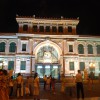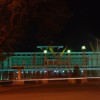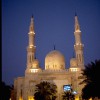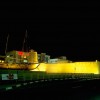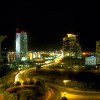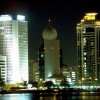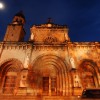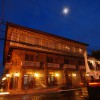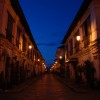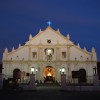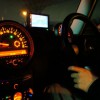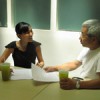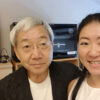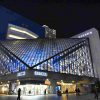Published:Dec.05, 2017
・Activity 1/Lighting Survey:Mumbai (2017/10/02-10/07)
・Activity 2/Lighting Survey:Kagoshima (2017/10/25-10/27)
・Activity 3/Shomei Tanteidan descend on Ueno Park vol.2 (2017/10/16,11/13-11/14)
Lighting Survey in Mumbai
2017/10/02-10/07 Mikine Yamamoto + Leon Hitsu
We researched the biggest economic city of India, Mumbai. It is located west coast of India, which was used to call Bombay. This is the second time we researched this city since we last did in 2004. The goal of this research is to compare how its architecture and lighting have developed, and to compare with Navi Mumbai (New Bombay) developed as a new city of Mumbai.
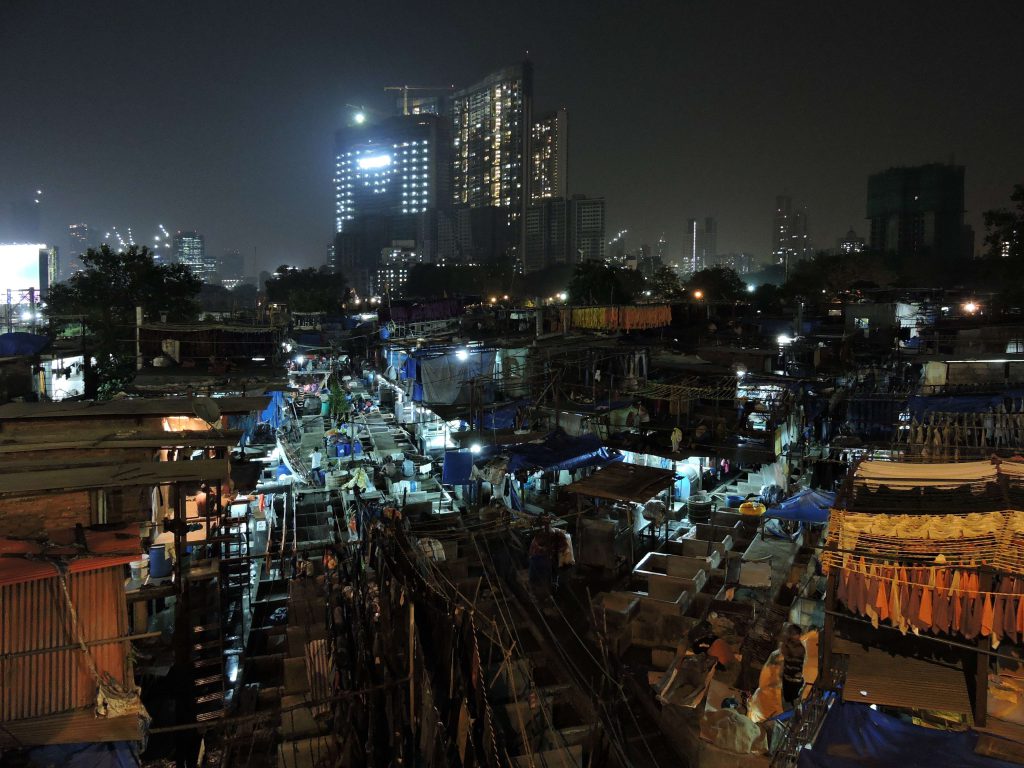
Dhobi Ghat is an outdoor laundry with more than 100 years of history. It is used as a laundry in the daytime, though people lived there and felt a sense of life in the nighttime. The contrast with the skyscraper in the background is very Indian.
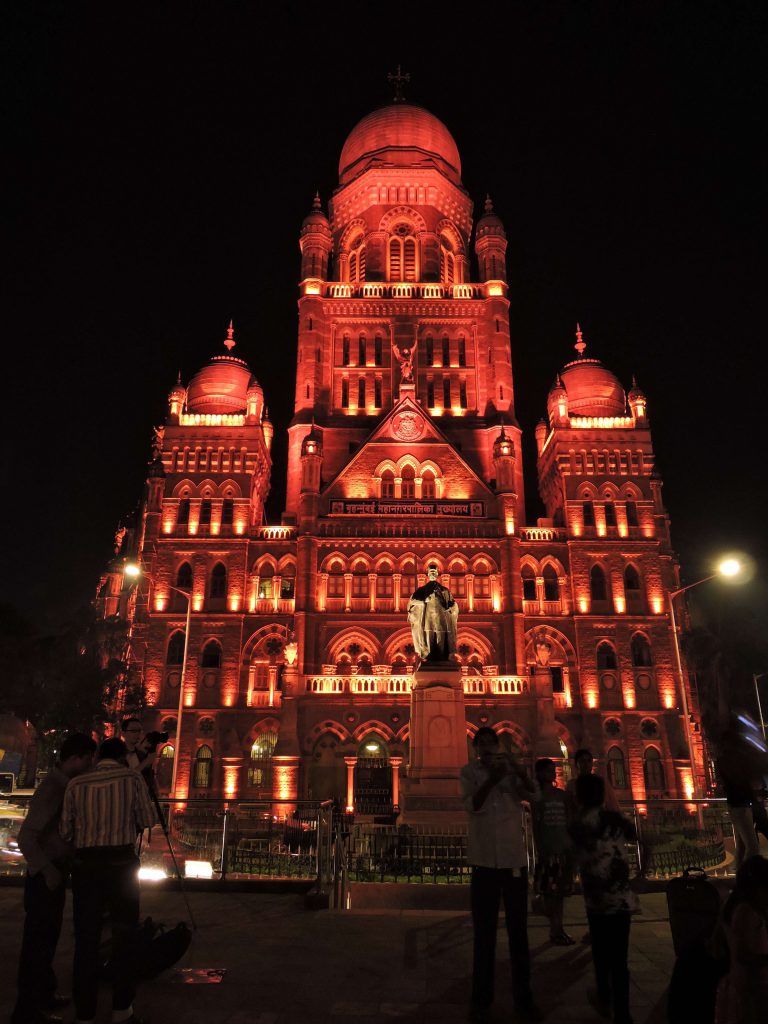
The building in front of the station. Building was carefully lit up with orange color.
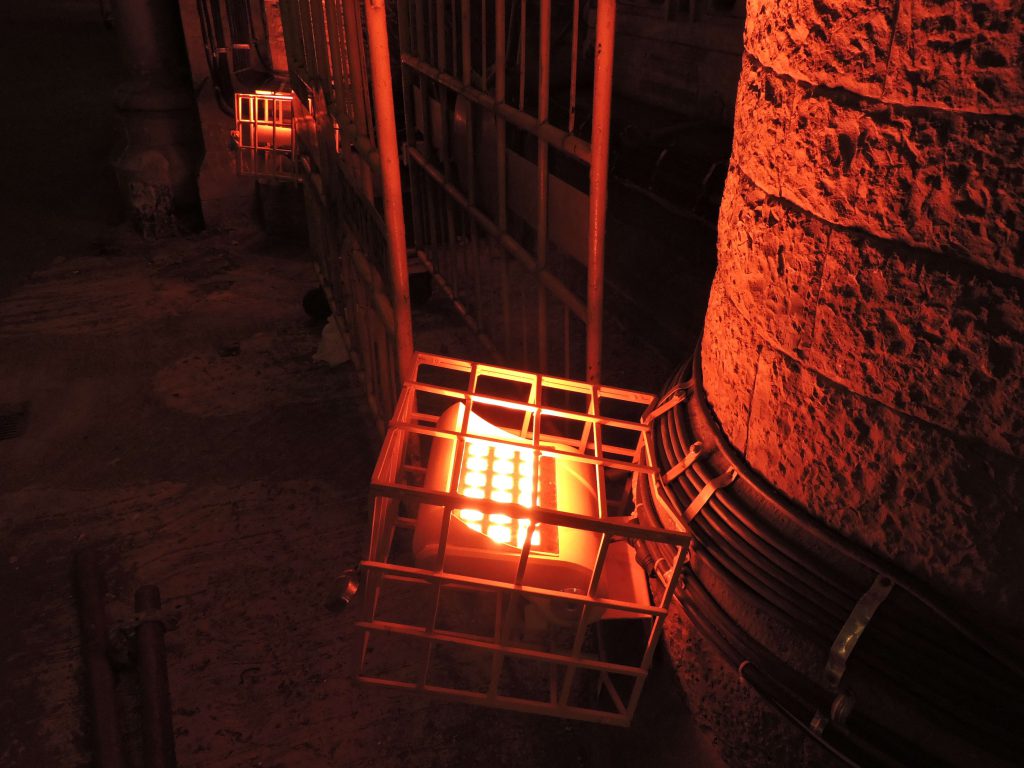
Mounting details. The hood was installed in the fixture in order to avoid glare when seen from the front
Arriving at Mumbai hotel after the sunset, from the taxi on the way to the hotel, I only saw street lights that lit the street, and the city that was on the background looked dark and sunken. We expected that it was developed like China where a number of buildings lit up, but there was no building that was illuminated. The situation didn’t change even in the city, with only seeing street light illuminating the building a little. Entering the central part of the city, the horning sound is flying constantly. As the taxi moving slowly, we saw many people doing something on the street and created strange atmosphere. It’s was not like attracting and energetic lighting that gives atmosphere of Southern East Asia, but it was impressive to see many people doing something relying on only dimming street light. We saw few changes from last research, and it seemed Mumbai had not been developed much.
■Lighting for Landmark
There are a few buildings that exist as landmarks in Mumbai. India Gate which was built to celebrate the visit of Kind of England in 1911. In front of that, there is world leading Taj Mahal Hotel. Chhatrapati Shivaji Terminus which was registered for world heritage in 2004. We researched Hajj Ali Mausoleum, the holy ground for Muslims.
Only lights we could see there were street lights, and there were only few illuminated building that gave solitary impression with window pane shining through. Buildings as landmarks were illuminated and characterized the town of night. LED was used for India Gate with orange color, and color lighting with motion was used for the station. In front of the station, there was a building that reminded colonial period, and the lighting was carefully designed with hood to cut the glare.
Hajj Ali Mausoleum floating on the sea used flood lighting of mercury lamp for illumination. It was not so impressive, but the road approaching the shrine that is in the sea was lit up with sodium that performed as a focal point with the different color temperature. We thought the dark sunken sea in the background and rarely bright night view of the city were also important elements. We can see the sunset in the evening, and the scenery gradually changing to night is very beautiful.
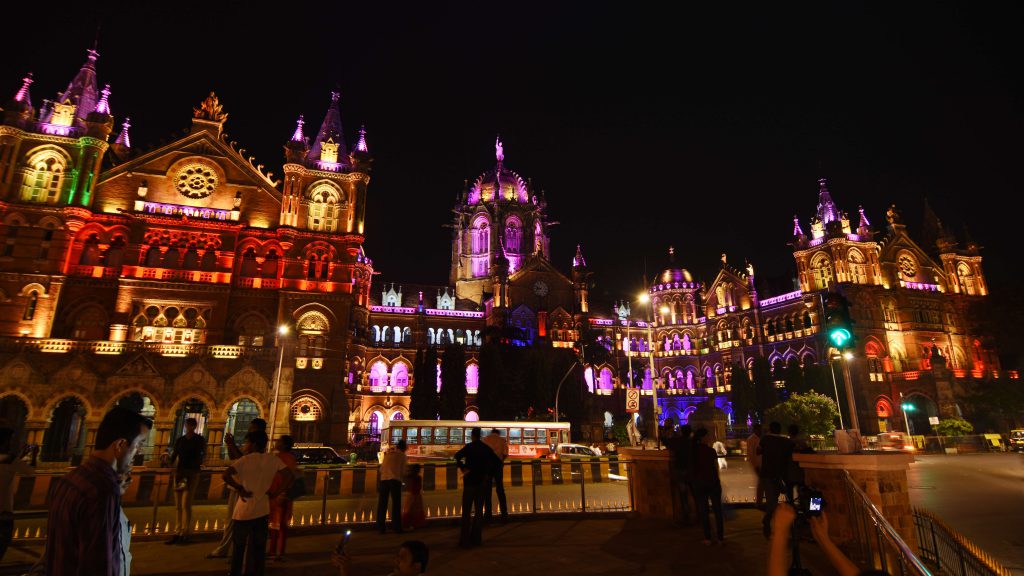
Chhatrapati Shivaji Terminus was built in 1887 and registered for world heritage in 2004. Its appearance in the daytime is very massive and designed in detail, but it looks like theme park using color lighting in the nighttime.
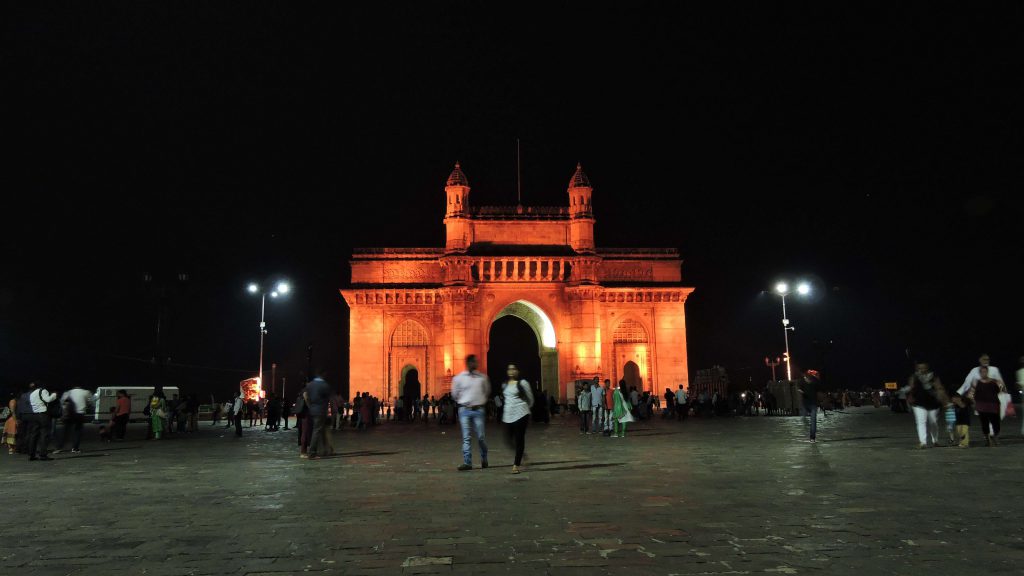
Orange colored flood light evenly illuminated the India Gate. Inside the gate, there was a white spot light that illuminated the roof.
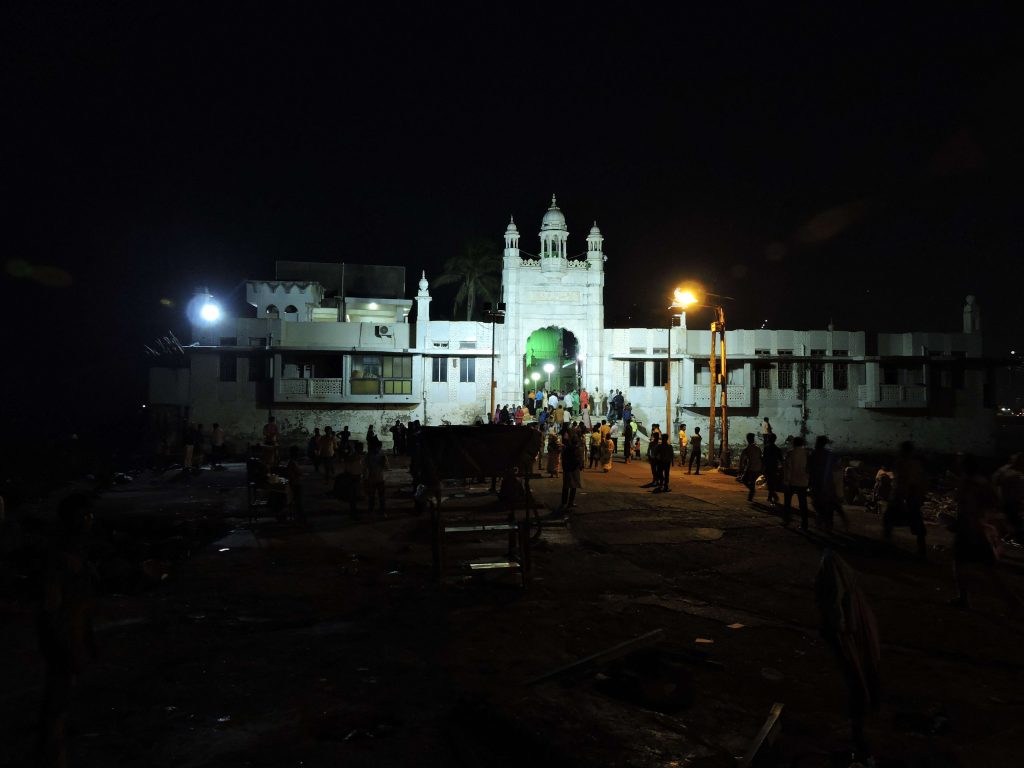
Approach of Hajj Ali Mausoleum. Approach was lit with sodium lamp, and Mausoleum was lit with mercury lamp.
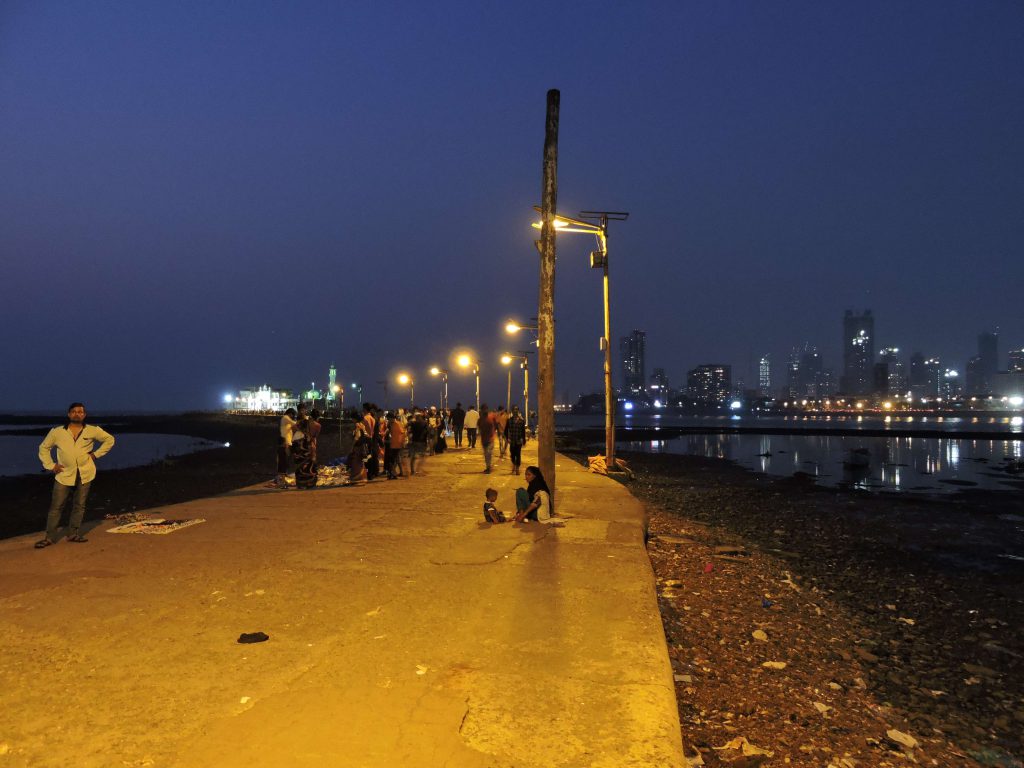
The appearance of Hajj Ali Mausoleum. Many people gathered in the floating mausoleum even at night. It was lit up with the flood light of mercury lamp.
■City that doesn’t have feeling of brightness
Gulf road called Marine Drive is a resting place for many citizens in the evening. The stride length along the revetment is 13 cm, and there were people walking and enjoying beautiful sunsets, couples, and many kinds of people. On the 50m wide road, including sidewalk, there were pole lights (H=12m) set up in about every 40m. Lighting fixture used LED. There was no lighting on sidewalk. Because it’s the main road, the lux level of roadway was about 25-70lux, and color temperature was about 4000K. It felt brighter than the other roadways around, which had 20-30lux. The lux level of sidewalk was about 5-15lux, and vertical illuminance level in the dark was less than 10lux, and we were only able to see person’s face a little. Trees were planted in between sidewalk and roadway which was comfortable darkness for bright roadway.
Around Mumba Devi Temple, market put out a store on the roadway that is about 9m wide, and it was flourished. It seemed like pedestrian at first, but the traffic of cars and motorcycles were very intense, and car horns were echoing constantly. Pole light with sodium lamp is was set up in 7m pitch in staggered arrangement, and the lux level was about 10-30. Many stores did not have lighting, and they were operating only with the street lights. Some stores were too dark to see what they were selling. There were a few stores that used fluorescent lamps or light bulbs so that we could see the items that were sold.
Street at Mumbai fundamentally has street lights only, and there aren’t any signs or lightings. Stores are closed at night. There aren’t any vertical illuminances, and we don’t feel any brightness or bustling. Having people gathered is important, but we also felt that the lighting was significant for bustling at night.(Mikine Yamamoto)
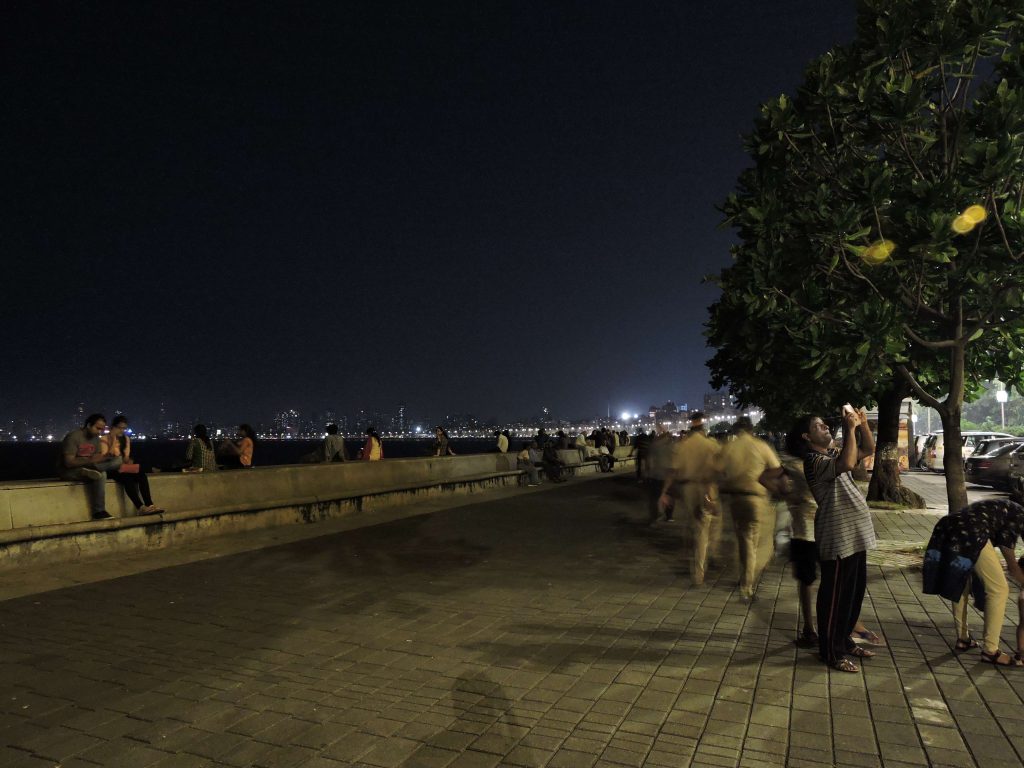
Sidewalk of Marine Drive. Sunsets and moonlight looked very beautiful.
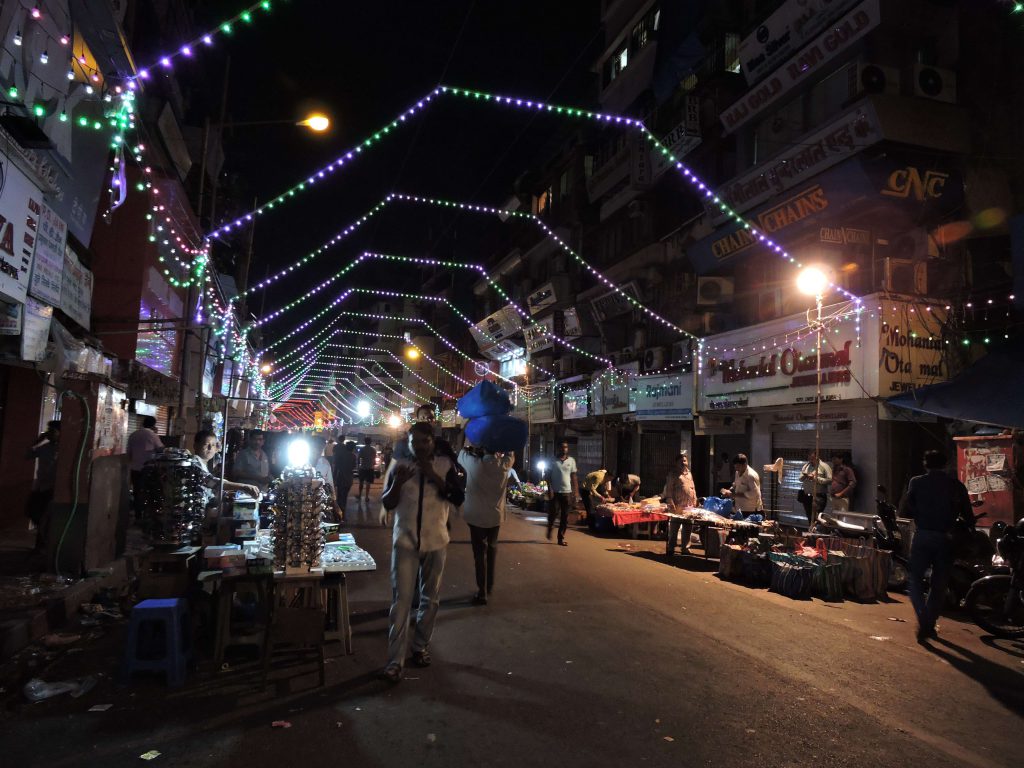
Bazaar around Mumbai Devi Temple. People are putting out stores under street lights.
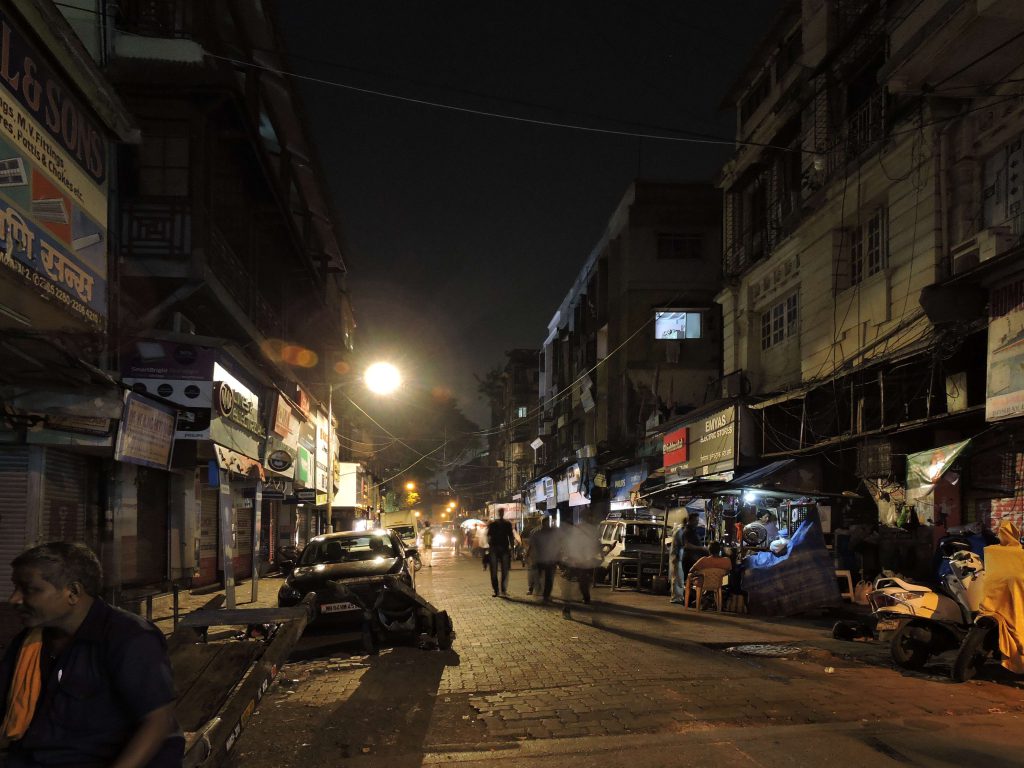
There are only street lights, and we don’t see signage or lightings in the store.
■Task light shines
In Mumbai, lightings usually fulfill functions, but not to enjoy night views. There are only lightings for functional necessity just like turning on lights when it’s dark.
Street light seems to be time operating turning on at 6:30 pm. That time is when Mumbai sunsets. Then, it gradually starts getting dark. Road illuminance was about 10-30lux.
Same for indoors. With brilliant facade lighting, Chhatrapati Shivaji Terminus platform is constructed with a large roof of 80m wide and 250m long. A large roof had a skylight that kept the brightness of the station using the daylight.
Lighting was wide angled high power LED. Its height is about 8-9m to match with the beam. It is set up on grid in of 8m pitch from front to back and from side to side. The color temperature in platform at night was about 6300K, and the lux level was uniform with 200 lux Internally illuminated signage was easy to understand, though high color temperatures, bare metal frames and digital sings had an impersonal feel.
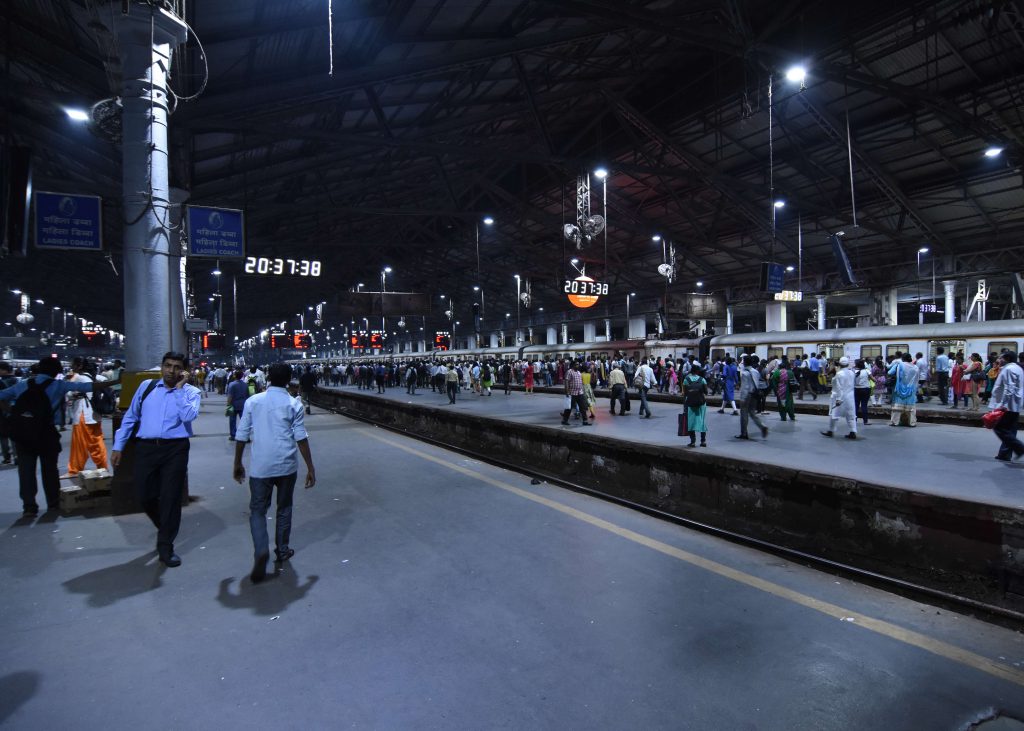
Bright platform of Chhatrapati Shivaji Terminus
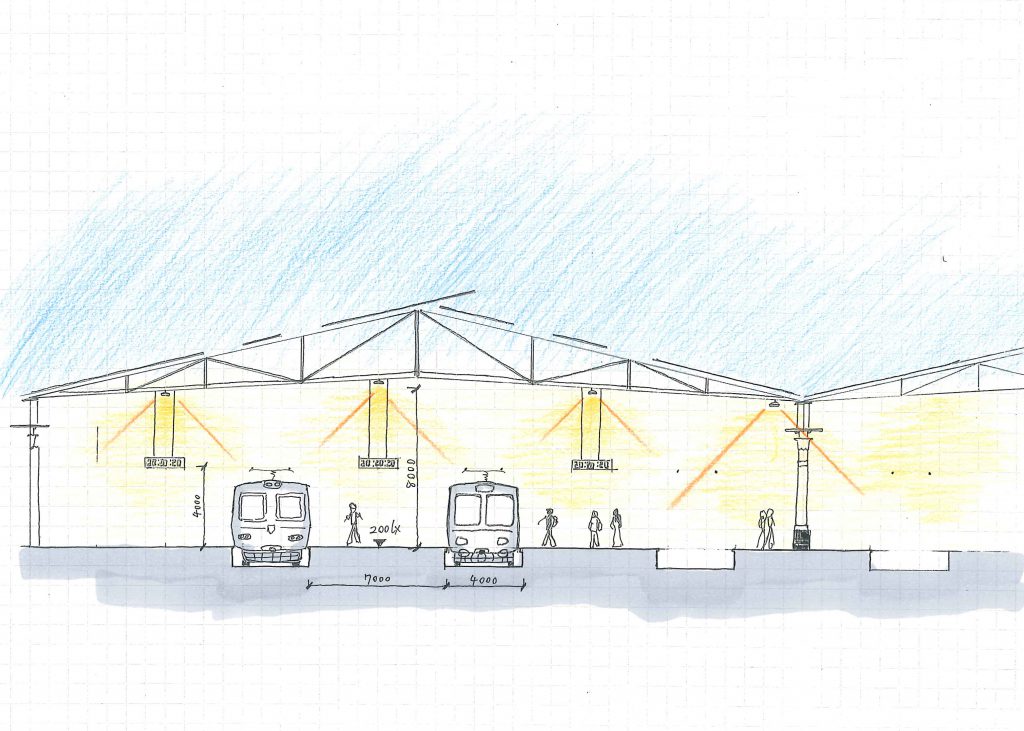
Platform structured with a large roof.
■Mumbai and Navi Mumbai
The structure of Mumbai city was complicated. It was crowded with skyscrapers and low-rise buildings, and bright areas and dark areas were mixed. On the other hand, Navi Mumbai is a newly constructed planned city, and northern part of the city has many office buildings and factories, while southern part had public facilities including housings, parks and stadium. It is easy to understand the structure of this city because road’s vertical and horizontal lines are very clear. Seeing from the night view’s perspective, there weren’t any vertical illuminance to highlight buildings. They were unable to express the city’s characteristics and its atmosphere at night. In Mumbai, skyscrapers and landmarks are built continuously. However, once the night falls, it becomes shadow in the dark, and we felt it very wasteful, but at the same time, there are more places for improvement.(Leon Hitsu)
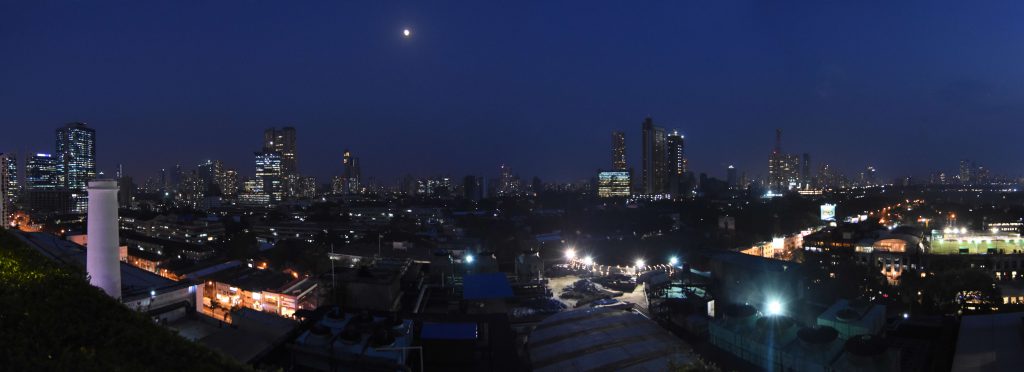
At night in Mumbai. There isn’t any lighting for façade other than pole lighting.
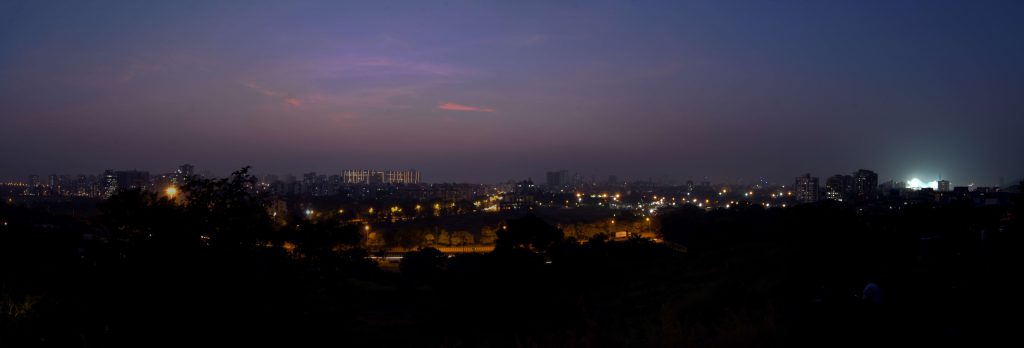
At night in Navi Mumbai. Mixed-used facility of shopping mall and a hotel with vertical line lighting can be seen from the distance.
Lighting Survey:Kagoshima
2017/10/25-10/27 Shunichi Ikeda + Yuri Araki
Kagoshima city is a city which its urban area is integrated with nature and magnificent scenery, and it is also a tourist attraction that is represented by Sakurajima. It has scenery unique to Kagoshima city such as a view to Sakurajima, Japanese modernization asset like historical buildings, and urban scenery with slanted green area in the background. We researched the light environment of this highly regarding scenery formation area with Sakurajima as a main axis.

Night view of Kagoshima seeing Sakurajima. There isn’t any color lighting or building advertisement on city in front of the Sakurajima.
It takes 1 hour to get to central area of city from Kagoshima airport. It was very exciting and felt good to have a drive looking at clear sky, rich water and greens, and magnificent Sakurajima with rising smoke. When we arrived at urban area, we started from researching about urbanscape planning, so we visited city hall that is a little walk from statue of Saigou Takamori. After that, we checked up main roadways in central areas and parks, history and culture area, commercial area, etc, and started preparing for a research about lighting environment.
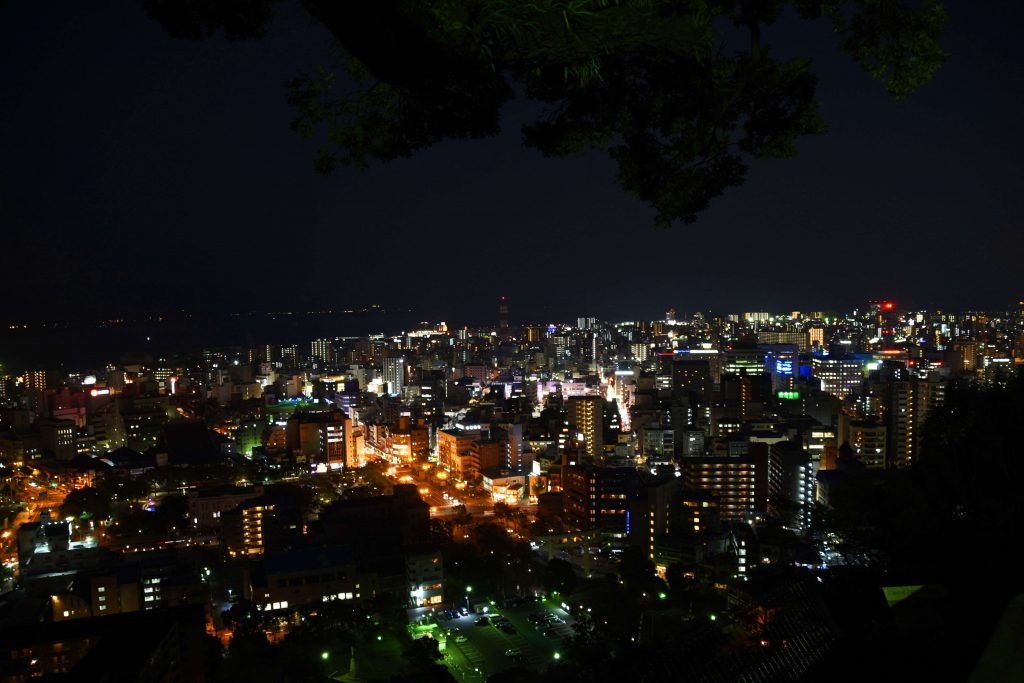
Night view of Central Kagoshima station from the same observatory. There are color lightings and building advertisements.
■Night view of Kagoshima
When the street lights started to turning on and the city was gradually taking on liveliness of night, Sakurajima gradually sank like it was sucked into the dark. We weren’t expecting to see the mountains being lit up commercially because those were pride of the area and were divines since long time ago. However, we felt wastefulness seeing Sakurajima sinking in the dark as night scenery of tourism resource.
When we observed it closely, we realized that there were only few striking color lighting and building advertisement in the city. We think the lighting is evidently considered to keep a sophisticated view. The reason why we think so is because around the central station which is out of sight from this observatory has Ferris wheel and commercial buildings with flashy lightings.
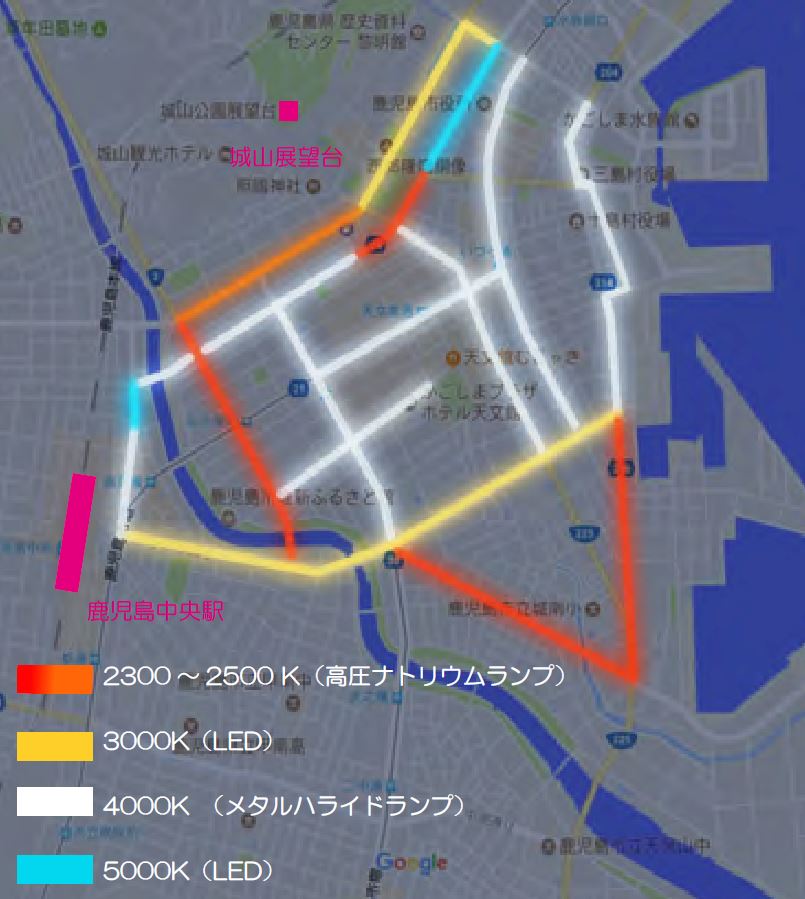
Map represents the color temperature of the street lights.
■Street lights of central area in Kagoshima
Street lights of central area is set up differently that has basically semi-cut type that lights under the direction, ball type that lights in all directions for roads that the tram runs with the car, street lights that looks like designated gas lamp for historical buildings. Street light of Kagoshima Port Line that goes through very close to Kanie Bay had a family crest of Shimazu family of former Satsuma domain lord and symbol of harbors and waves, and crabs, designs that represented Satsuma.
Talking about light environment of on streets is using orange colored high pressure sodium lamp, white metal halide lamp (4200K~) overall, and part of street and streets lights that looks like gas lamp uses LED. Most of the street lights (lamp set up on telephone pole) set up in narrow alley were replaced with white (5000K) LED and feels glaring. Overall, it seems like street lights in here isn’t really turned into LED.
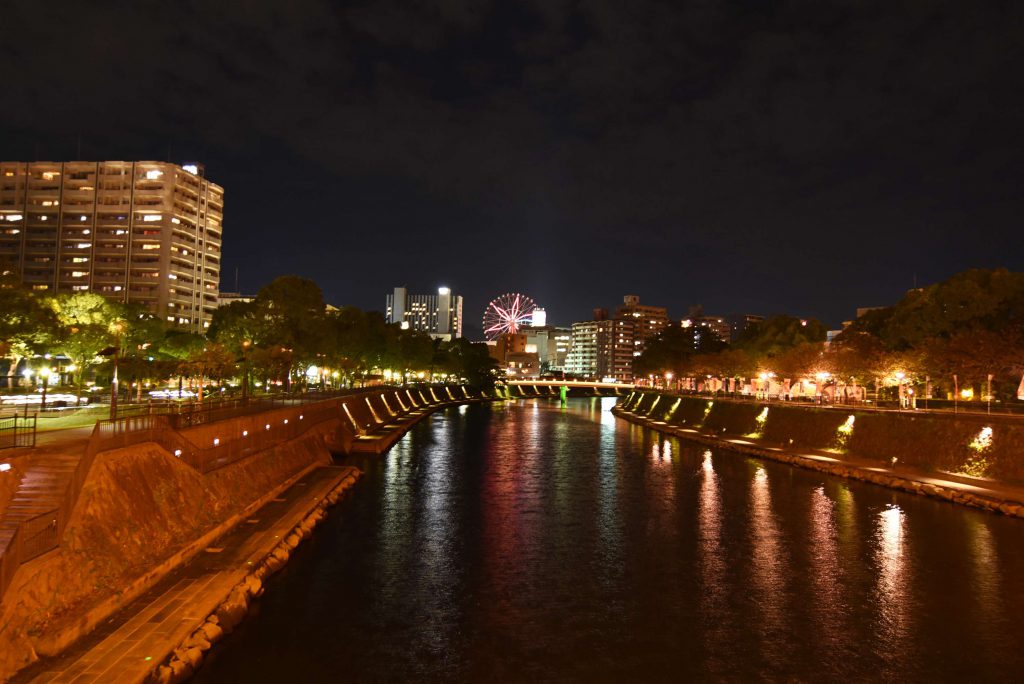
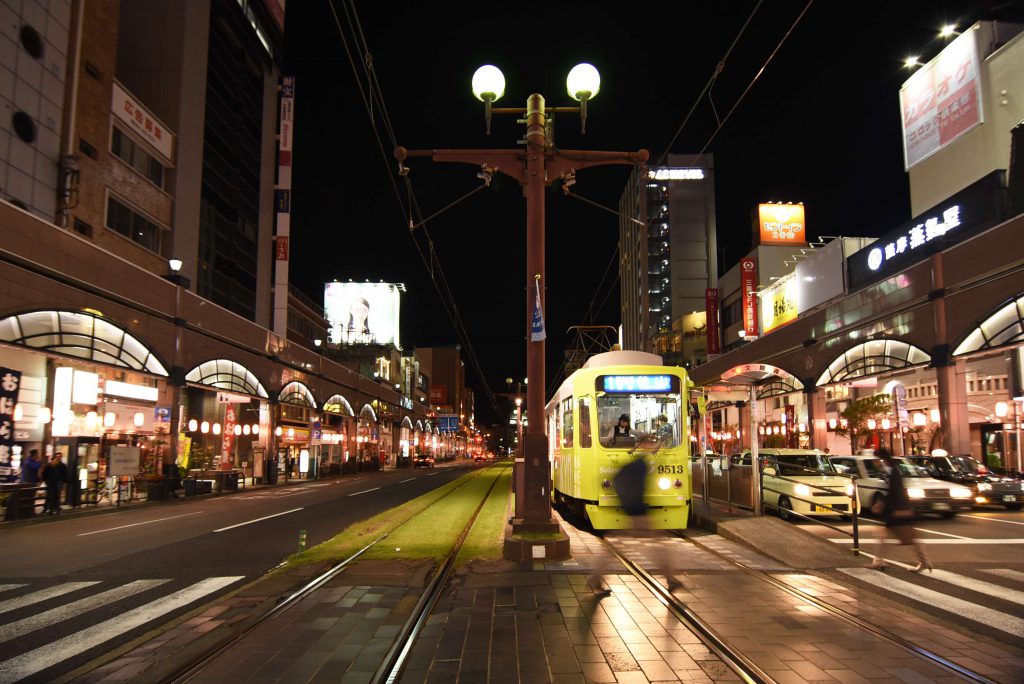
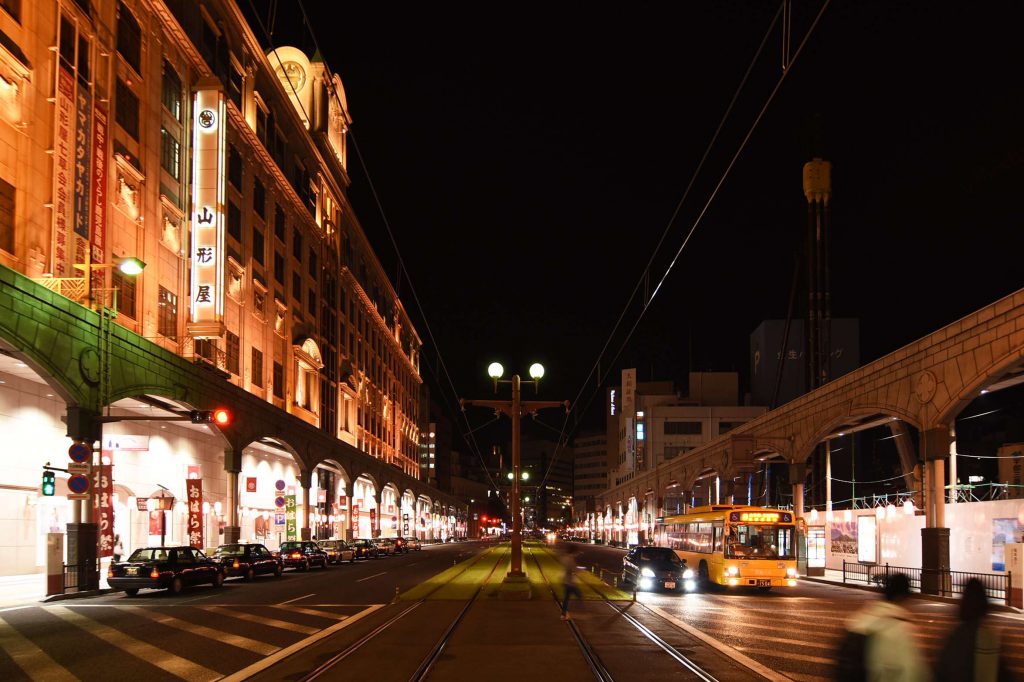
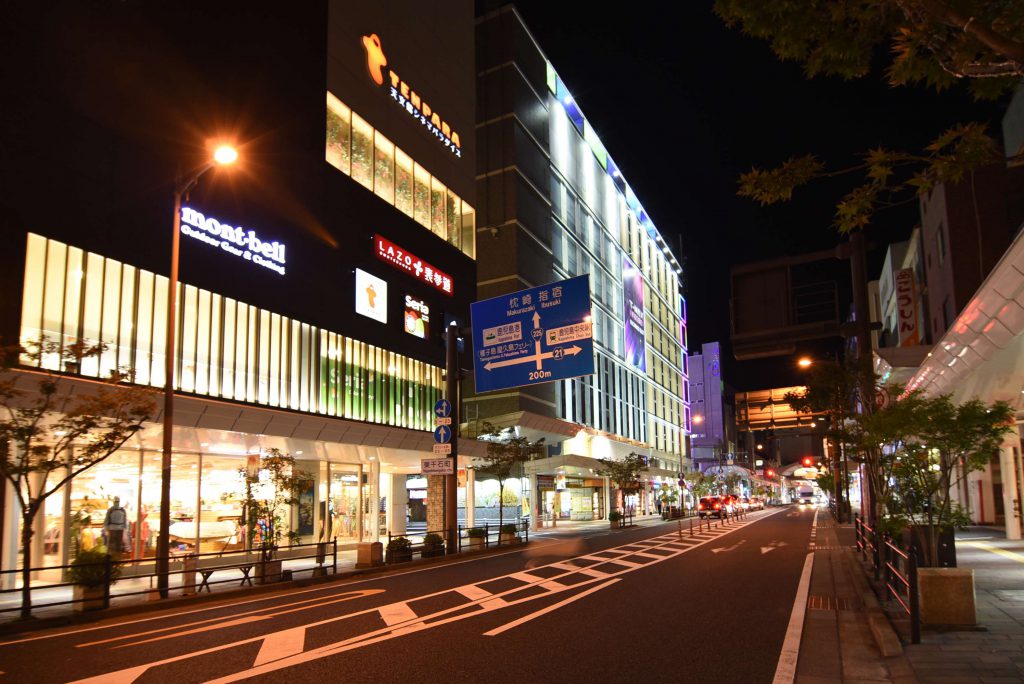
There are flashy façade lightings in commercial area of Route 225
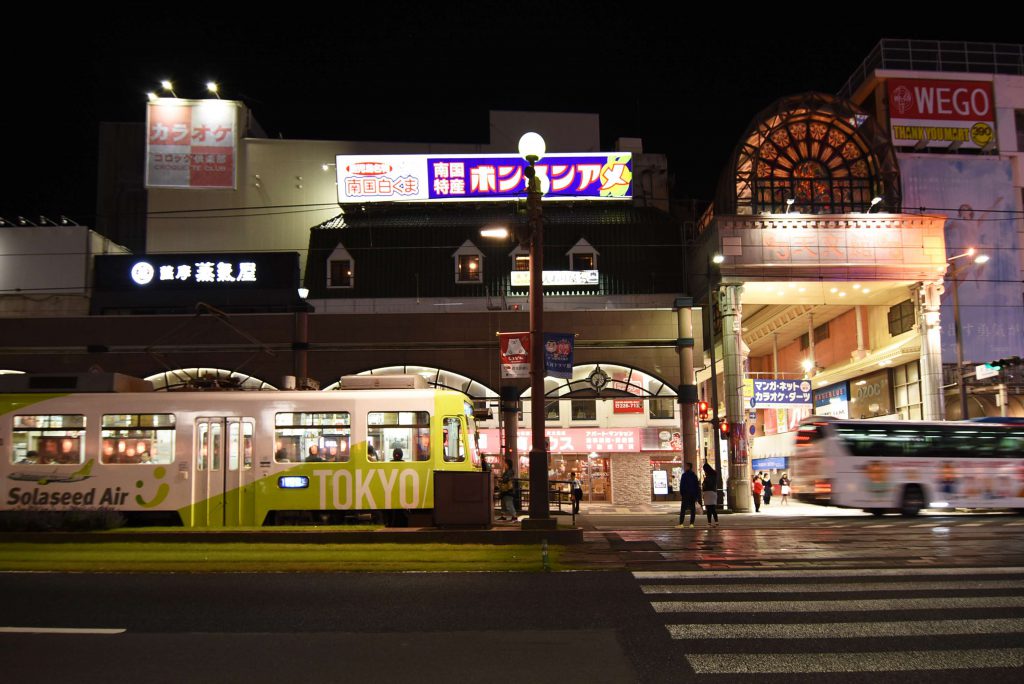
Front of arcade is flourished at night.
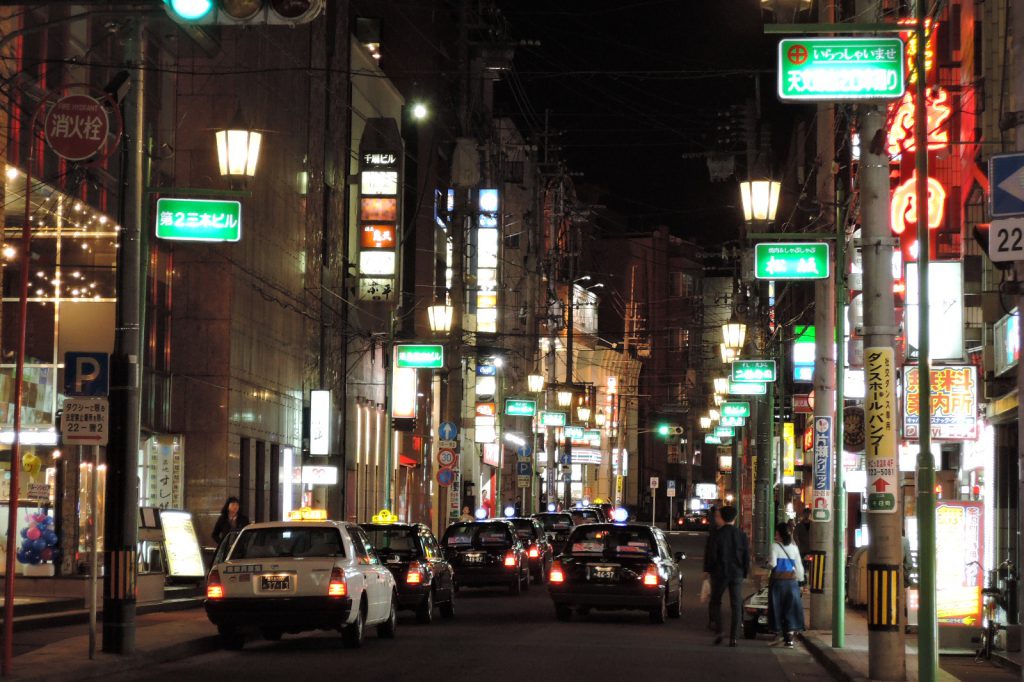
Flourished downtown area. A sign lit up green really stands out.
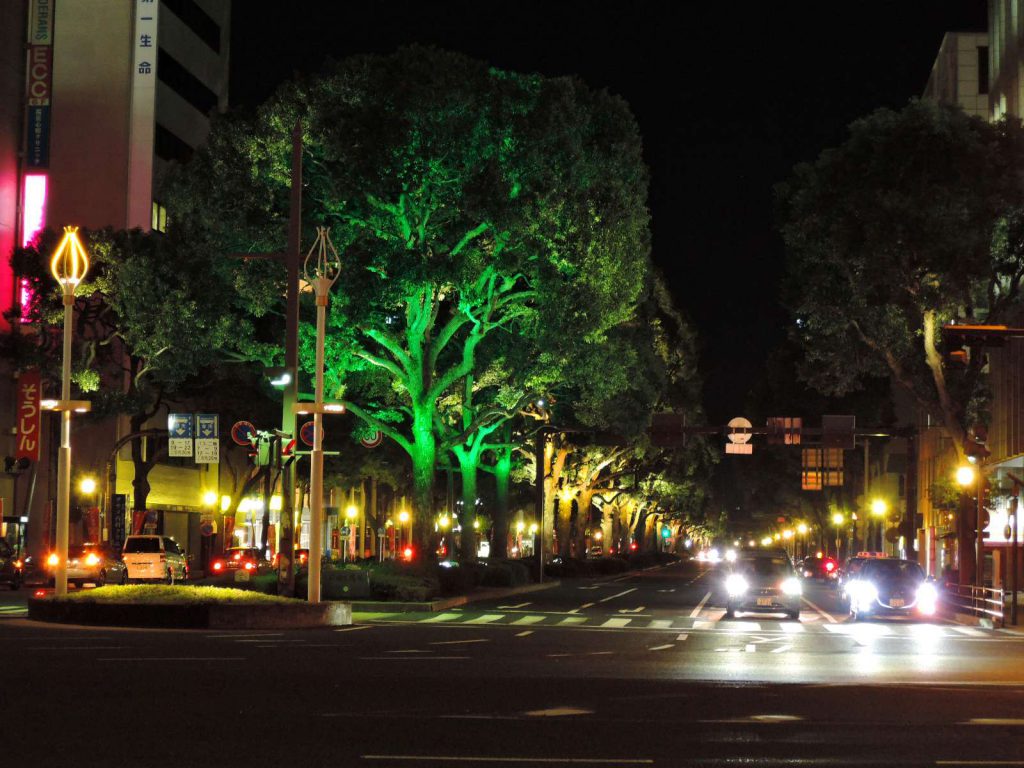
Trees in front of central station were lit up in green.
■Street lights of Naples Street that doesn’t get addicted to lux level
Naples Street and Perth Street that extend from central station to Kanie Bay is the area that re-equipped in recent years.
There isn’t any lighting for roadways, and there are 4m high pole light in every 15m on sidewalk and illuminated camphor tree in median strip. Lightings for trees lit up separately on purpose for leaves and stem with three different types of lightings of color temperatures that is about 2400K, 3800K, and 4200K. The lux level of roadways is 2-4lux, and about 11-22lux when close to pole light. So it is not that bright for Main Street, but illuminated camphor gives sense of brightness while colorizing the street dynamically.
(Shunichi Ikeda)
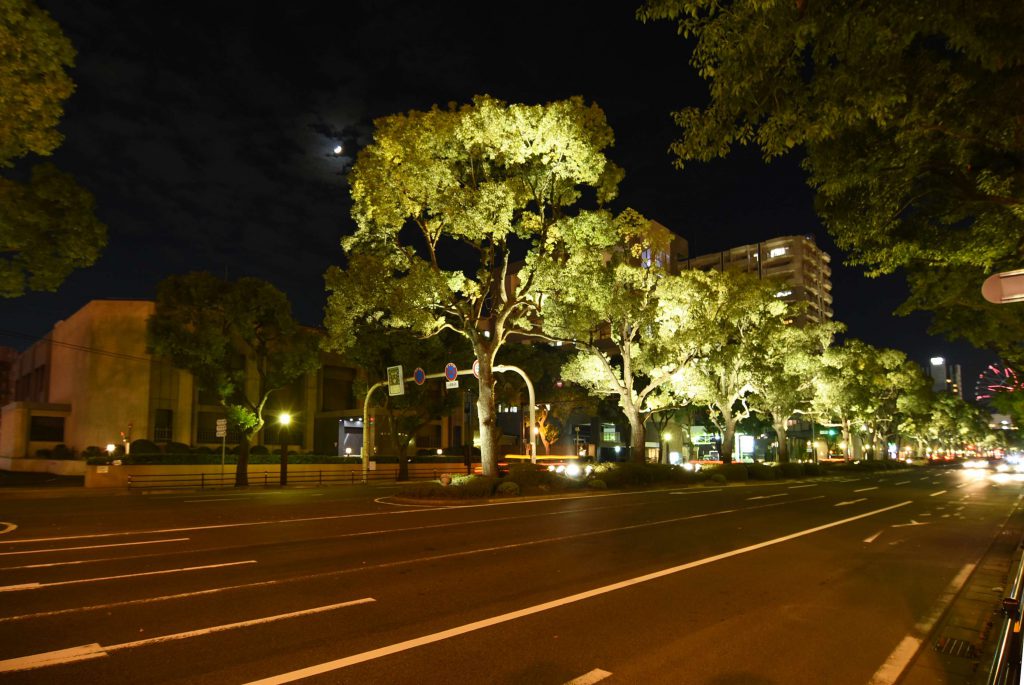
Impressing Naples Street with glittery illuminated camphor tree.
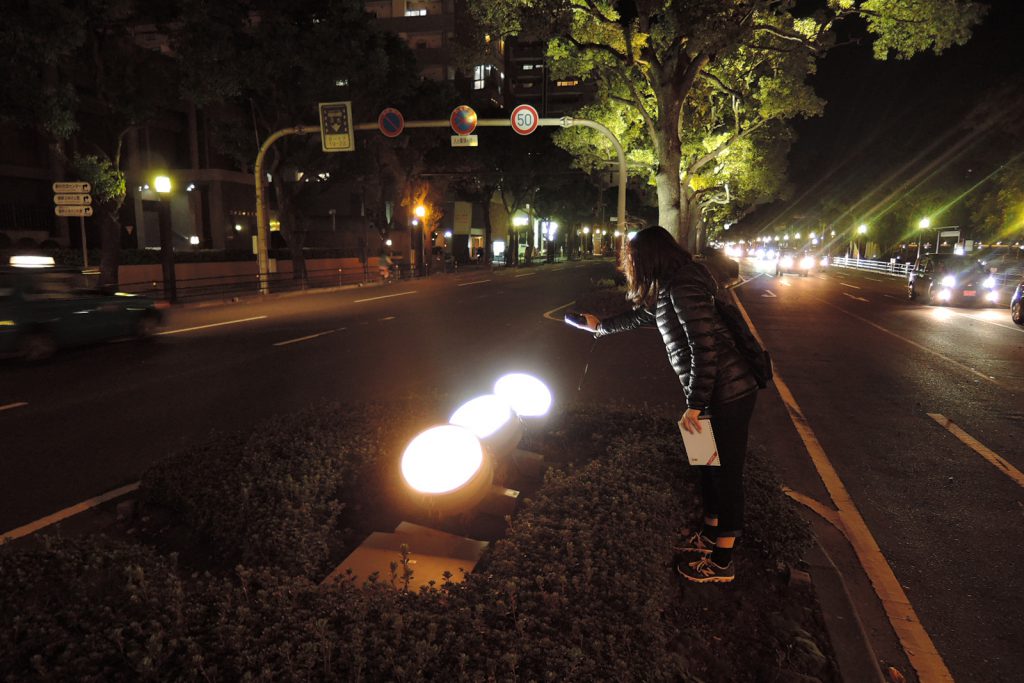
Different color temperatures are used.
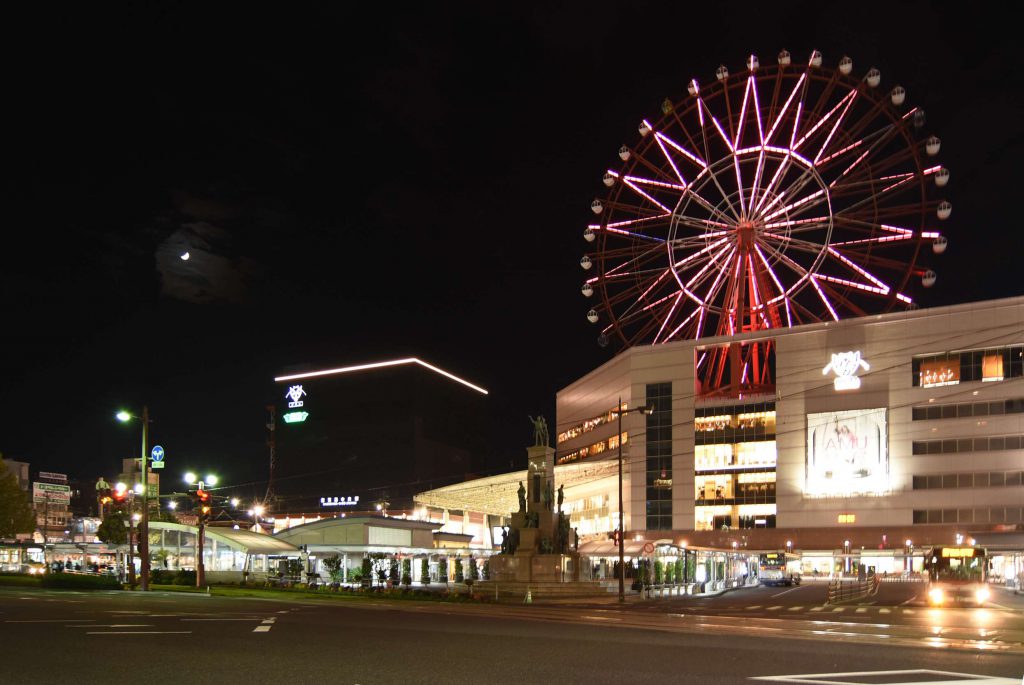
Commercial facilities line up lively in front of central station of Kagoshima.
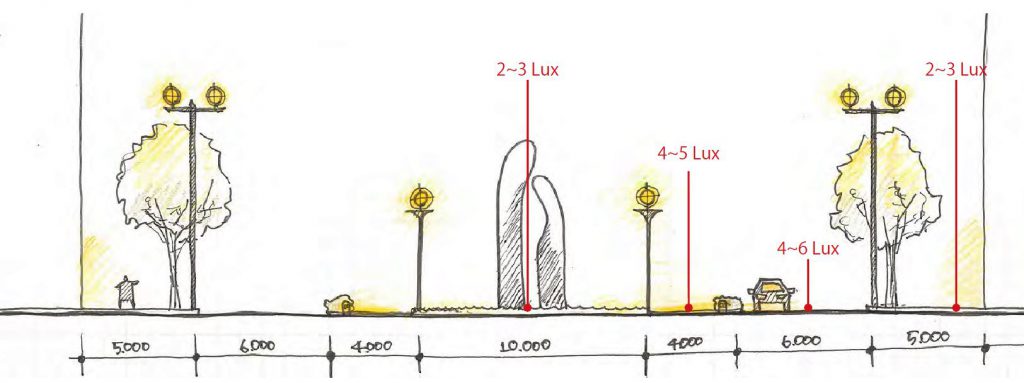
Sketch of cross section of Minato Main Street Park
■Main Street Park
Minato Main Street Park is located at where city hall and Sakurajima’s axis line meets. It’s 18m wide, and 350m to the beach that looks like road of lawn.
Two types of street light with unified design lines up on both sides of the park. This street light has globe shaped fixture, and it indicates the relationship with this pole light and that of tram line. The lux level of side walk is about 2-3lux, and the lux level of roadway is about 4-6lux which was not necessarily bright level. But because of the luminance level of street light and illuminated city hall located head of the park, it didn’t make the place dark, and made comfortable light environment.
However, even though we carried out a research at 8:30 pm, there weren’t people in and around the park and it was solitary. One of the reasons is locations which the park was far away from downtown and residential areas. We felt that if there are some factors that call in people, many of them will realize this park’s charms of comfortable atmosphere regardless of daytime or nighttime.
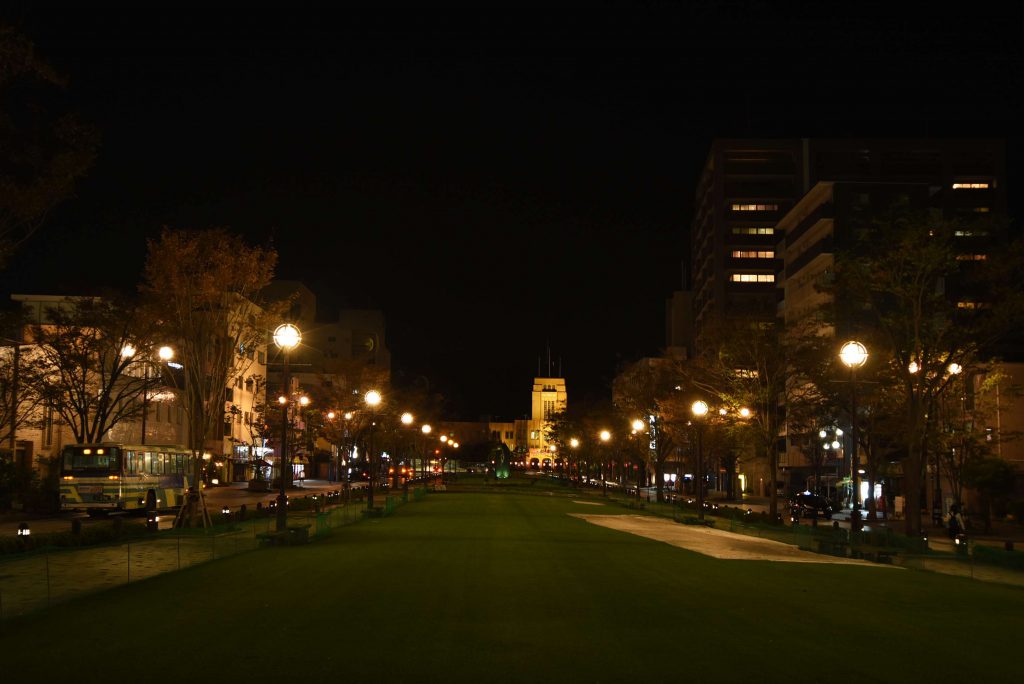
Minato Main Street Park. Lux level is uniformed overall by spread lamp
■Illuminated statue of Saigoh Takamori
When talking about famous photo spot in Kagoshima, statue of Saigoh Takamori comes up first. Tourists came and took photos continuously during the research in daytime. A big statue that is 8m high looks very imposing with the rich green in the background. On the other hand, Saigoh in the nighttime was a little disappointment. The reason why is that the trees around were lit up with white floodlight, but the statue standing in the center looked dull lit up with the lamp color. To be a popular photo spot at night, the color temperature of floodlight that illuminates trees and the statue should be replaced and arrange the lighting to make both statue and greens look beautiful.
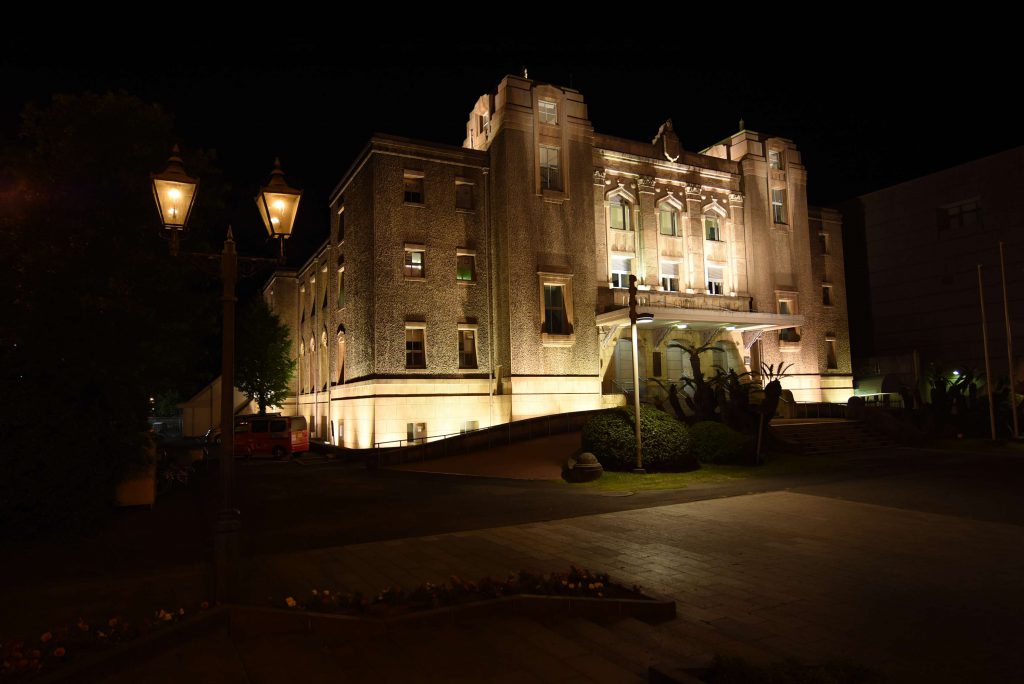
Central public hall with light-up
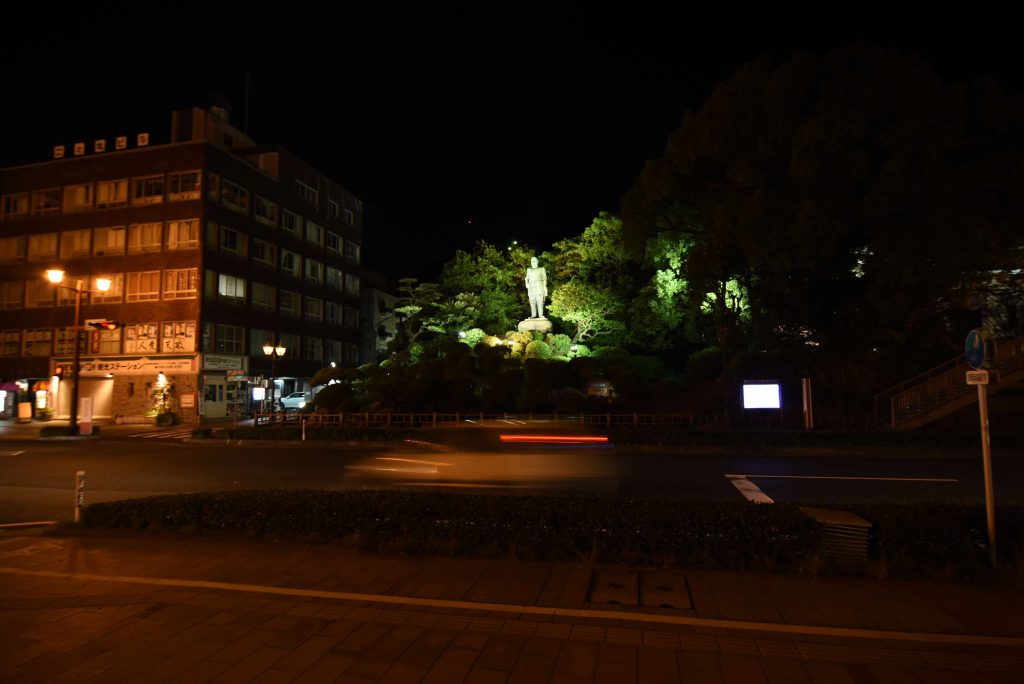
The statue of Saigoh Takamori is illuminated very brightly with warm color
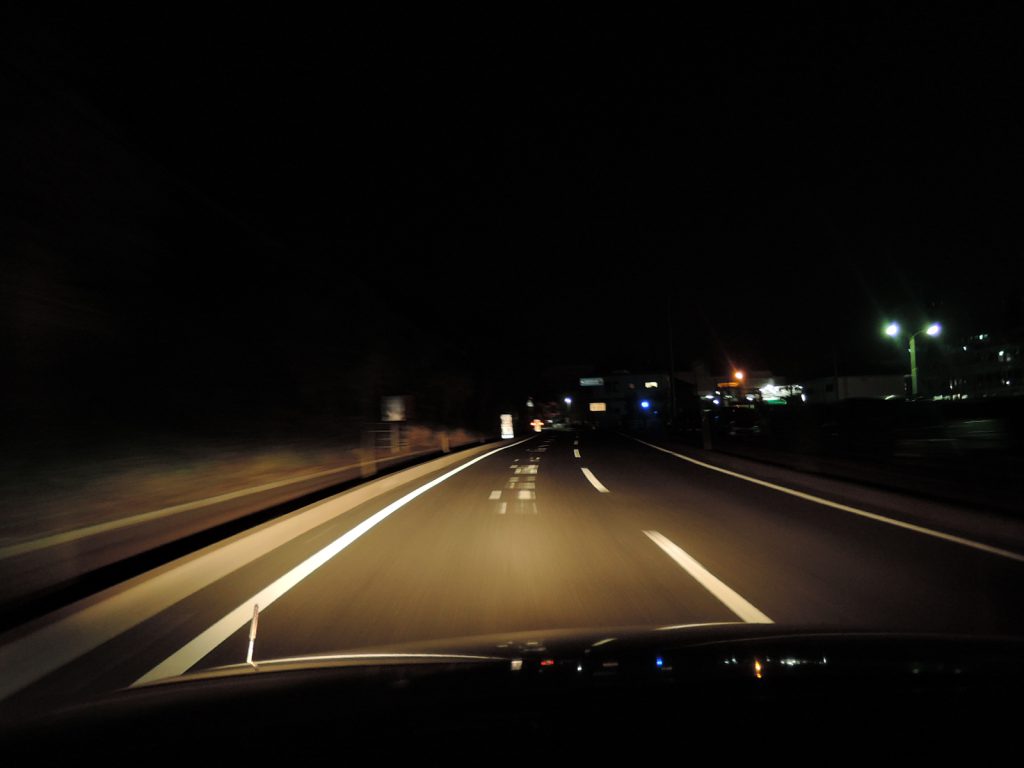
There are almost no street lighting in Sakurajima
■Night view of Kagoshima seen from Sakurajima
Sakurajima has many observatories, but this time, we decided to go to Yunohira Observatory located at west of island. From the Shiroyama Observatory ahead it is located about 6 kilometers straight putting Kanie Bay in between. Glaring white light gathers in the harbor where might have a certain regulation to achieve proper illuminance level, but still the warm color light occupies around Shiroyama Observatory. On the other hand, there are Ferris wheel given the color lighting, and white light of the mansion stands out around Kagoshima central station. Since there is almost no street light in Sakurajima, it turns dark immediately after the sunset, but around the ferry terminal on the way to urban area was bustling and it is clear that the station is necessary for daily life. During the research in the daytime, we confirmed that there are street lights close to evacuation pit. (Yuri Araki)
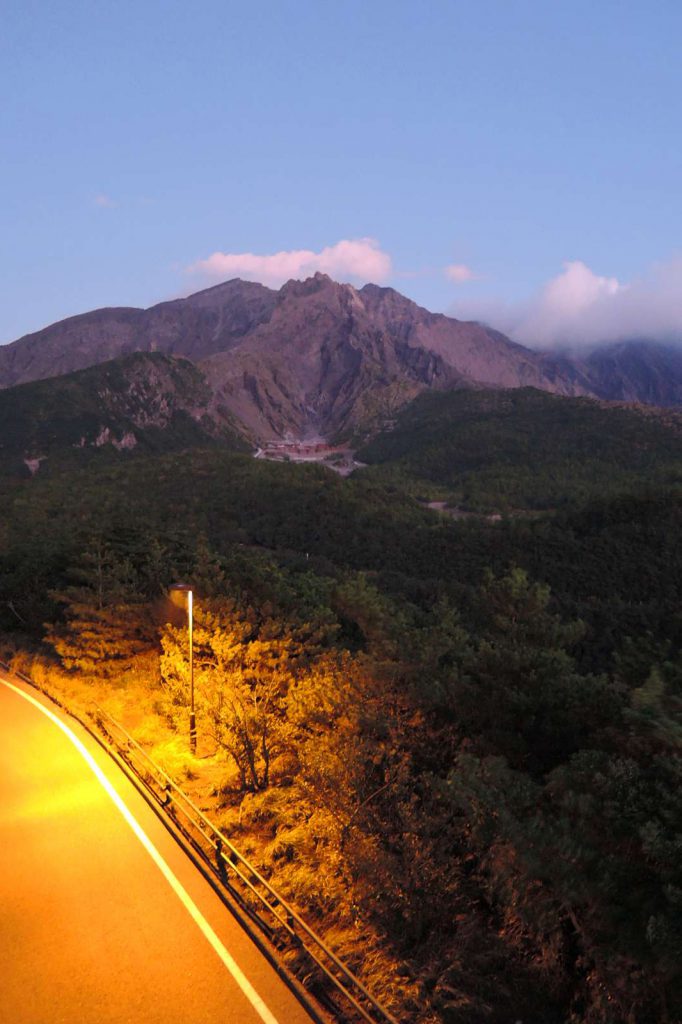
Sakurajima seen from Yunohira Observatory
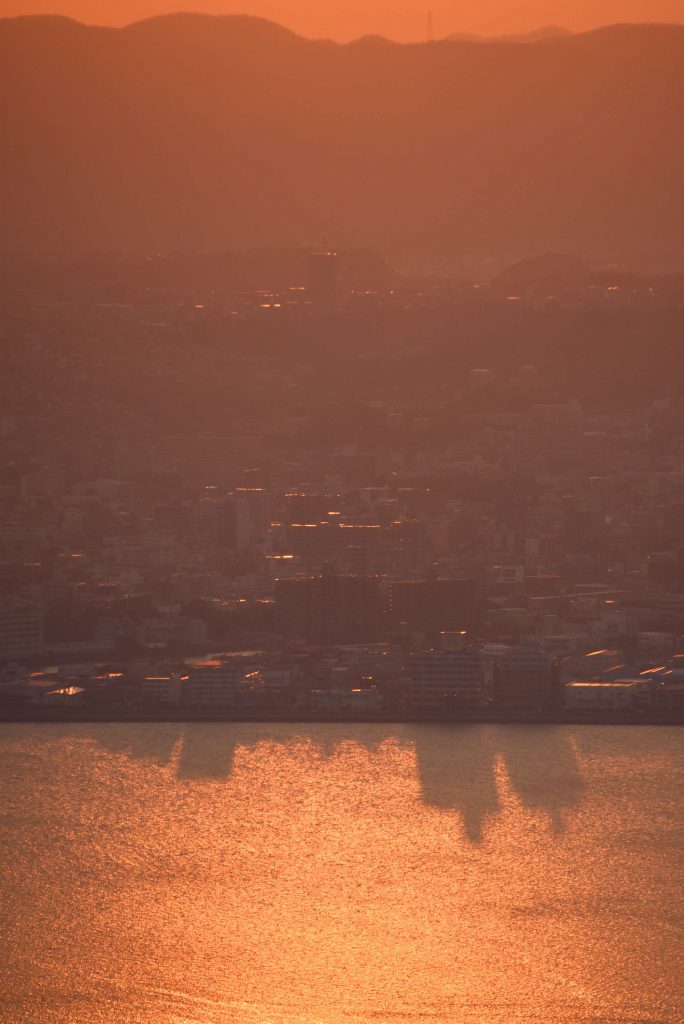
Shadow of buildings made from shallow angled setting sun
■After the research
We felt consideration of Kagoshima for night views from observatory to Sakurajima. Contrary to the scenery in the daytime that made Sakurajima as a main, brightness fades out from commercial area which the central station to Sakurajima. On the other hand, the city shines brightly like a main role when we view urban area from Sakurajima. Conversion of the main role formed by natural features and cultures may be the scenery unique to Kagoshima.
(Shunichi Ikeda)
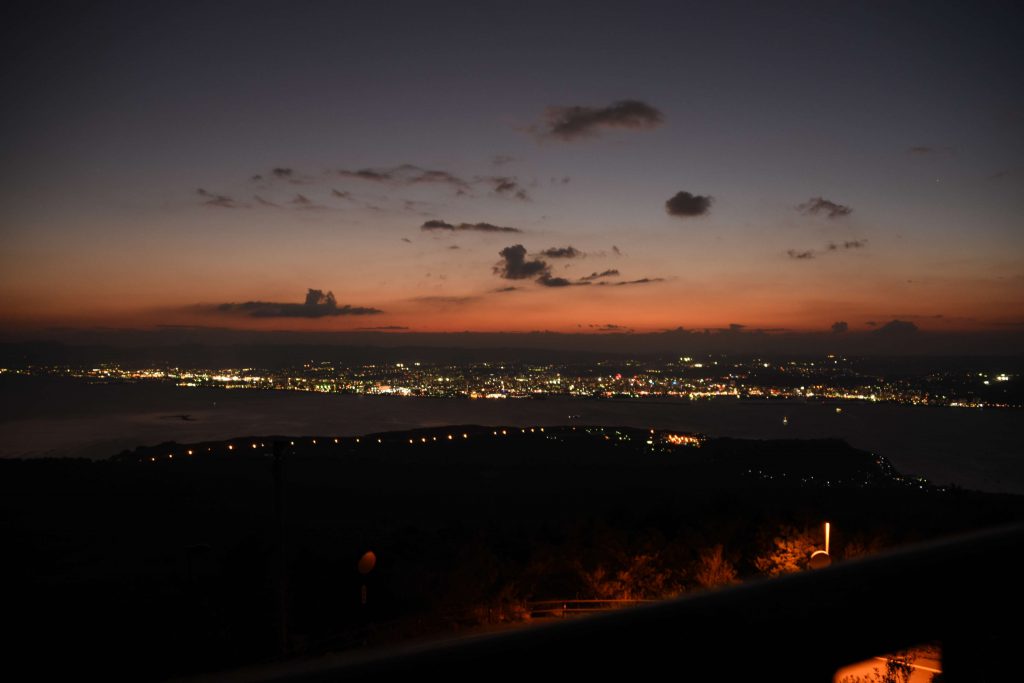
Sakurajima seen from Yunohira Observatory
Shomei Tanteidan descend on Ueno Park vol.2
Workshop to think about ideal way of light and future way of “Forest of Ueno”
2017/10/16,11/13-11/14 Haruka Takano + Toru Mori + Nobuyo Sato + Masara Akiyama + Koki Iwanaga
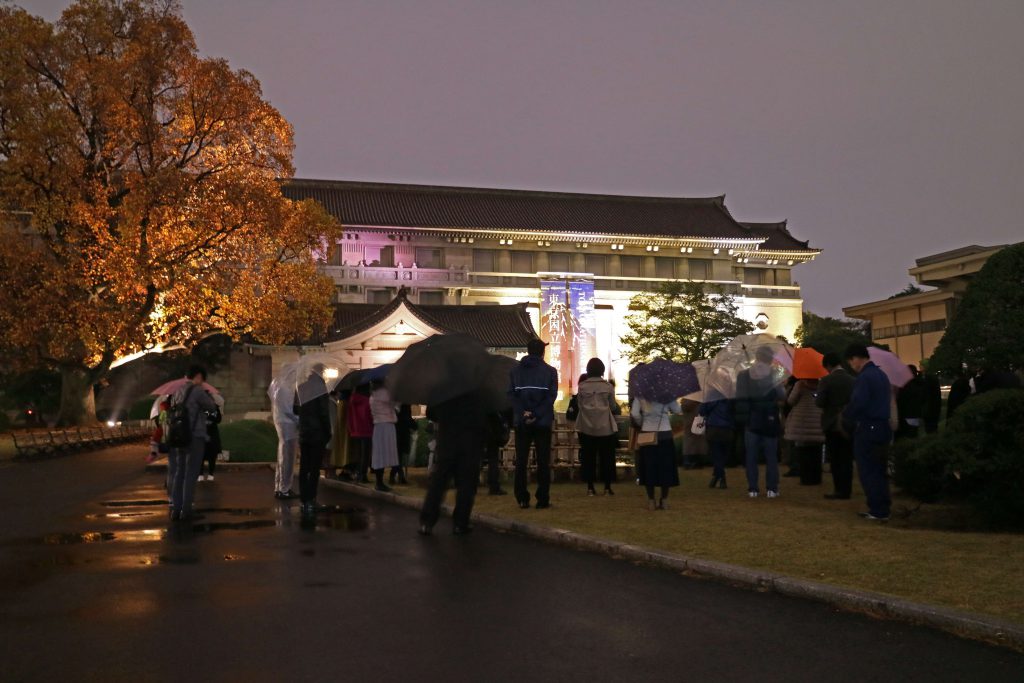
Lighting workshop at Tokyo National Museum. It was very precious experience to try out lighting plans
January and February of this year, we held a city walking workshop named “Ueno-Night-Park”. This is the second one of it. We carried out a workshop in Tokyo National Museum experimenting ideal way of light that we considered at field work last time. Illumination experiment was carried out during “The second Tokyo Suki-Festival”, and this workshop enabled not only participants but also citizens to rediscover the potential and its value of Ueno Park. (Koki Iwanaga)
■The first night: Lighting experiment and making of proposal
This time, we took 3 days to make a lighting proposal for Tokyo National Museum by bringing ideas from lighting professionals to students, house wives, and a wide range of people. Content was to set up the lighting fixture at the Japanese Gallery, Hyokeikan Building and an approach to Horyuji Treasures and illuminate and give presentation on the last day.
October 16th was the first night which was raining unfortunately. We started at 6 pm in Kuroda Memorial Hall, and moved to Tokyo National Museum and actually lit up the lighting fixture that was going to be used on performance. We confirmed each lighting fixture’s ability and characteristics by lighting from the second floor of Toyokan to Hyokeikan. After that, from 7 pm, we lit up the lighting that is usually carried out in Tokyo National Museum at night closing time and were able to observe/consider from many places.
When we finished researching at an actual place, we went back to Kuroda Memorial Hall and separated into Group A (Main building), Group B (Hyokeikan), and Group C (Horyuji Treasures・Kuromon, Black Gate) and started planning proposal of each location. The first night was scheduled very tightly with only 3 hours to research the actual sites and making proposal, but with participant’s active debate and creation of sketch, our expectation for the second night’s lighting experiment became higher. (Haruka Takano)
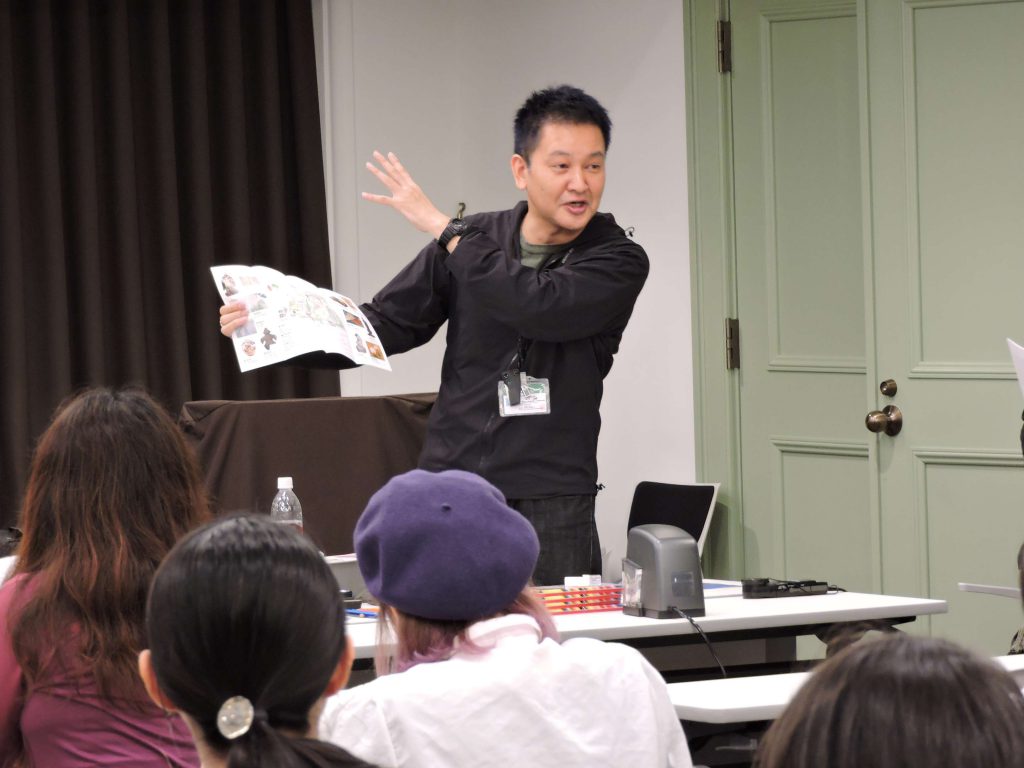
Mr. Kinoshita from Tokyo National Museum explains the point of the event
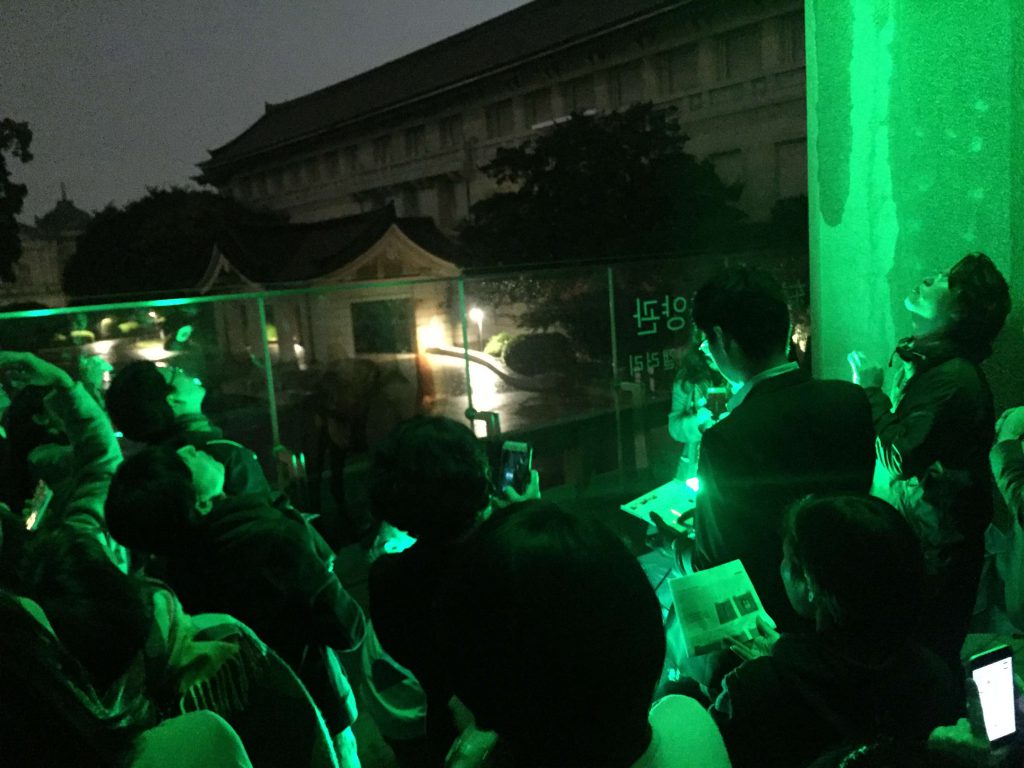
Scene of experiment of lighting up the roof of the main building from the second floor of Toyokan.
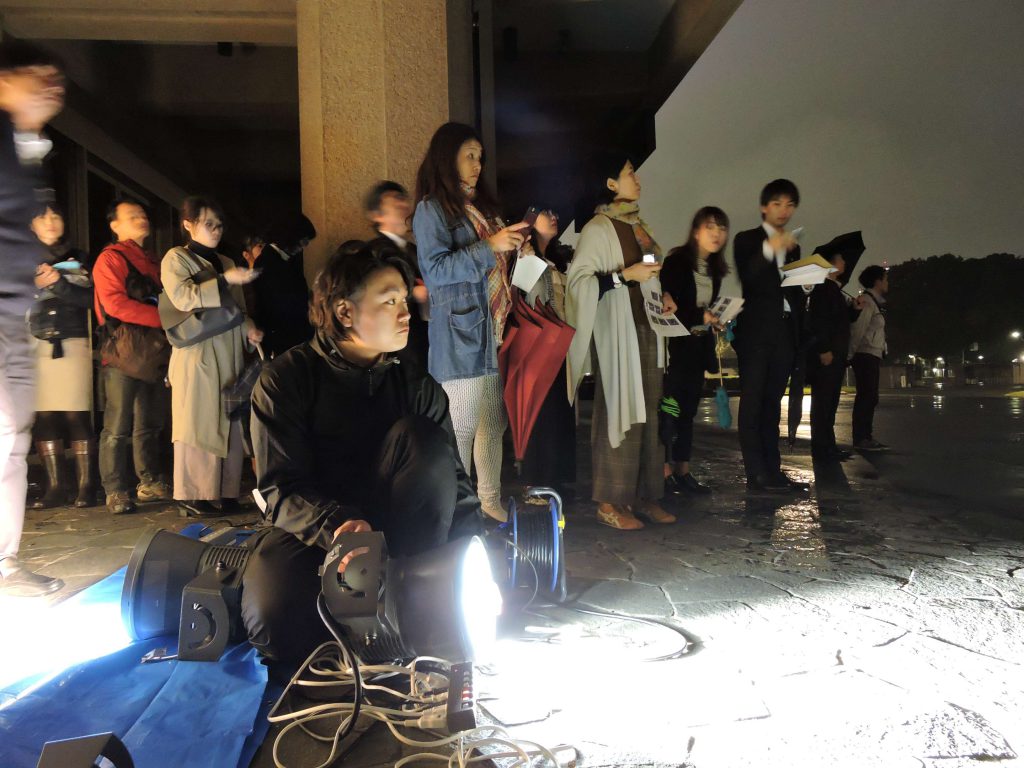
Using actual fixtures and confirming its effect
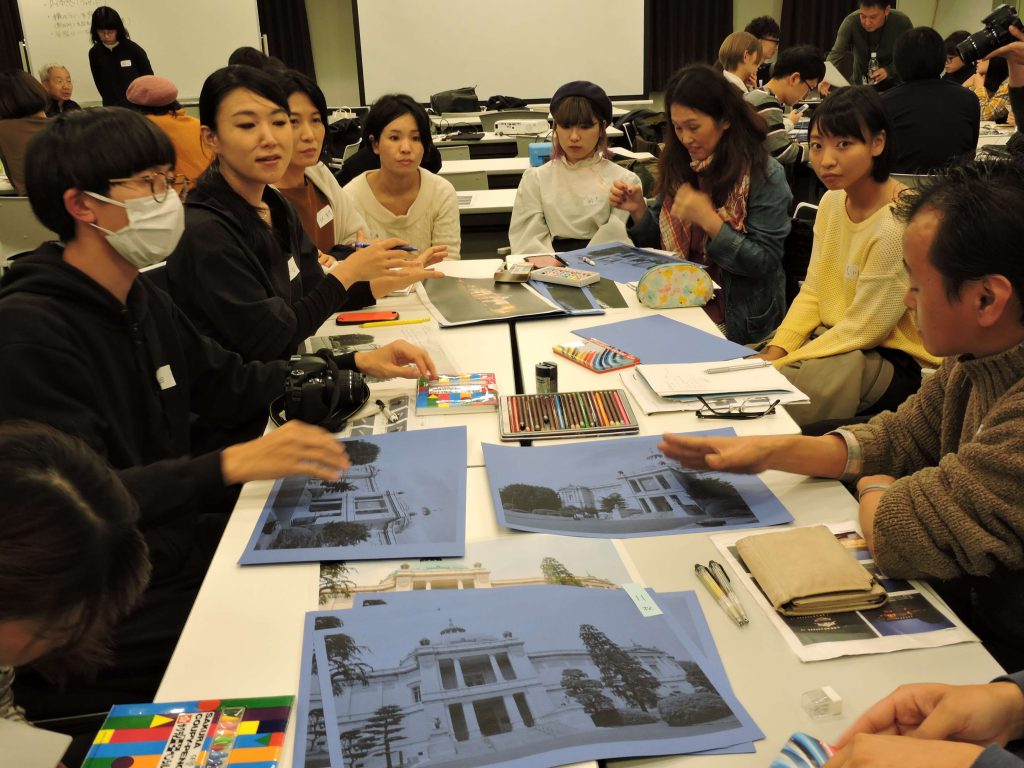
Separated into groups and made illumination proposal
■The second + third night: Lighting experiment + illumination performance
On the second night, November 13th ‘s workshop, we confirmed how the lighting plans that each group made is going to act lighting phenomenon in actual space, and conducted final adjustment to make ideal view. To prepare for the performance, we discussed ways of presentation of lighting plans for audience. November 14th was the day of the performance. We presented ideal lighting environment that each group considered. There was a group that performed with fancy arrange, and it was very spectacular for review meeting.
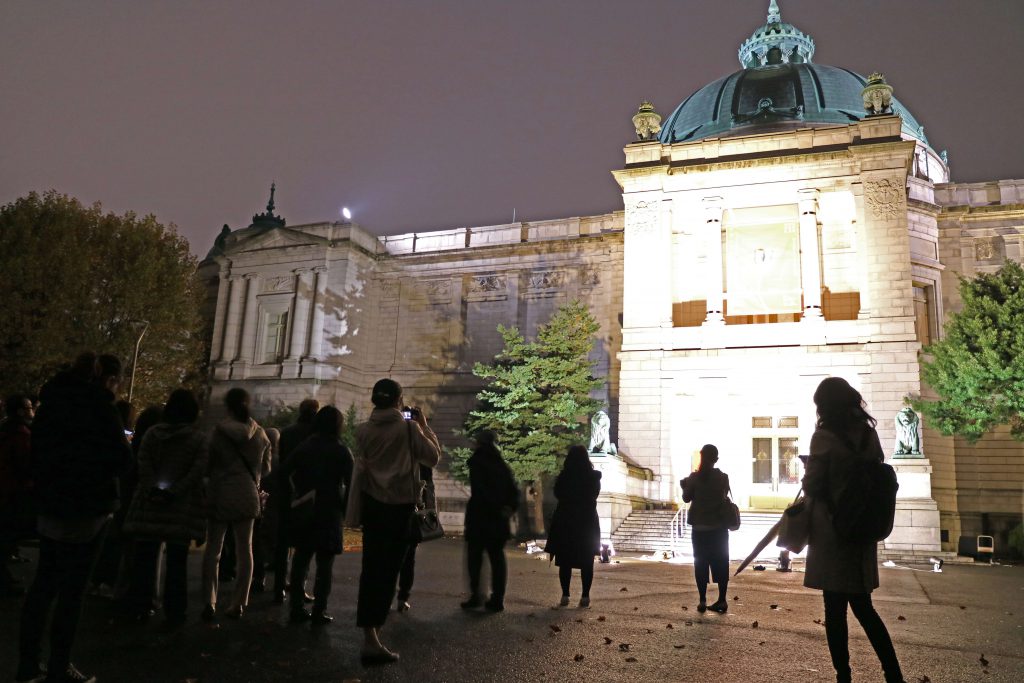
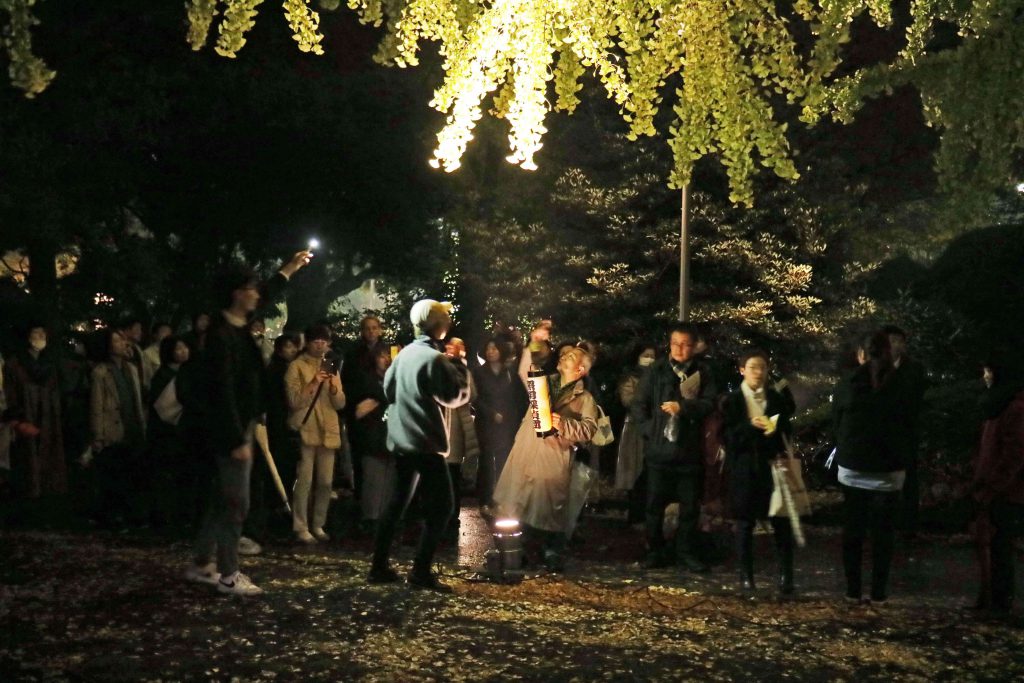
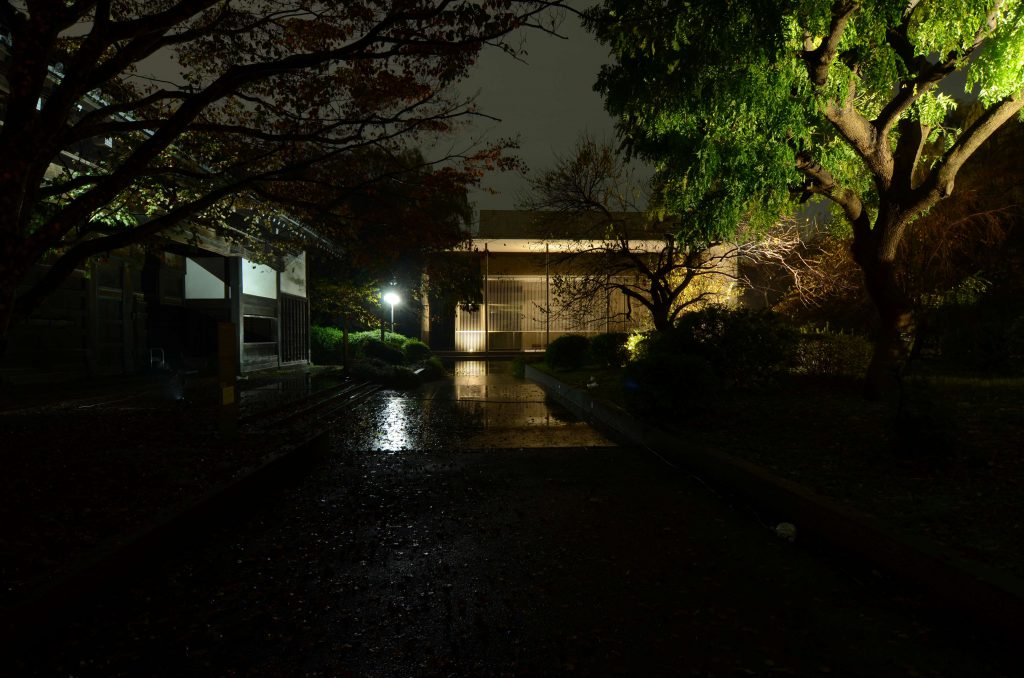
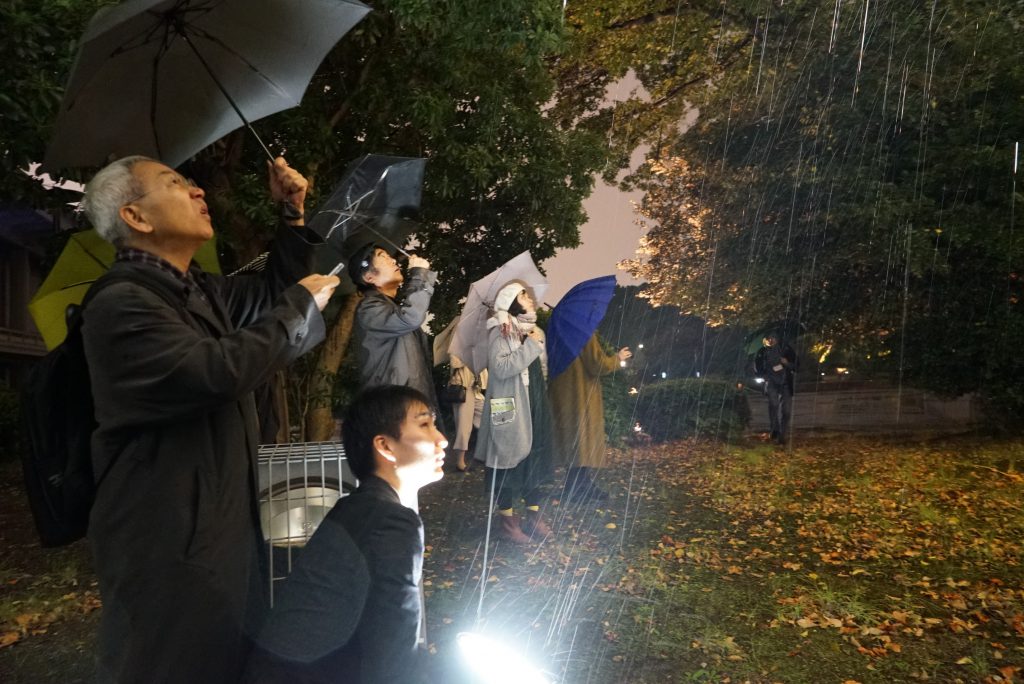
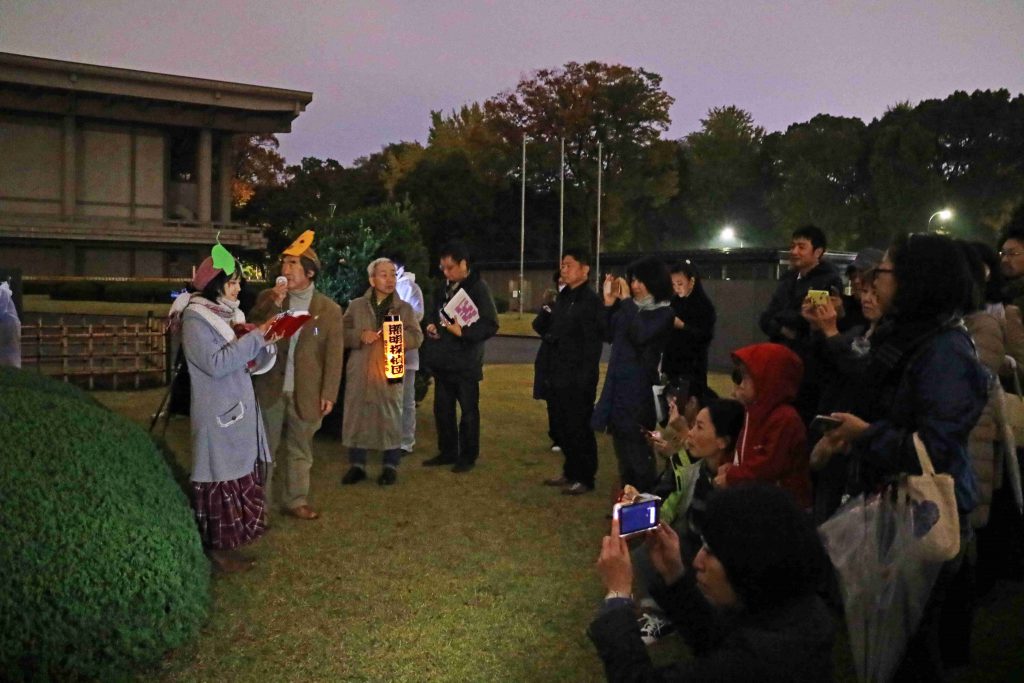
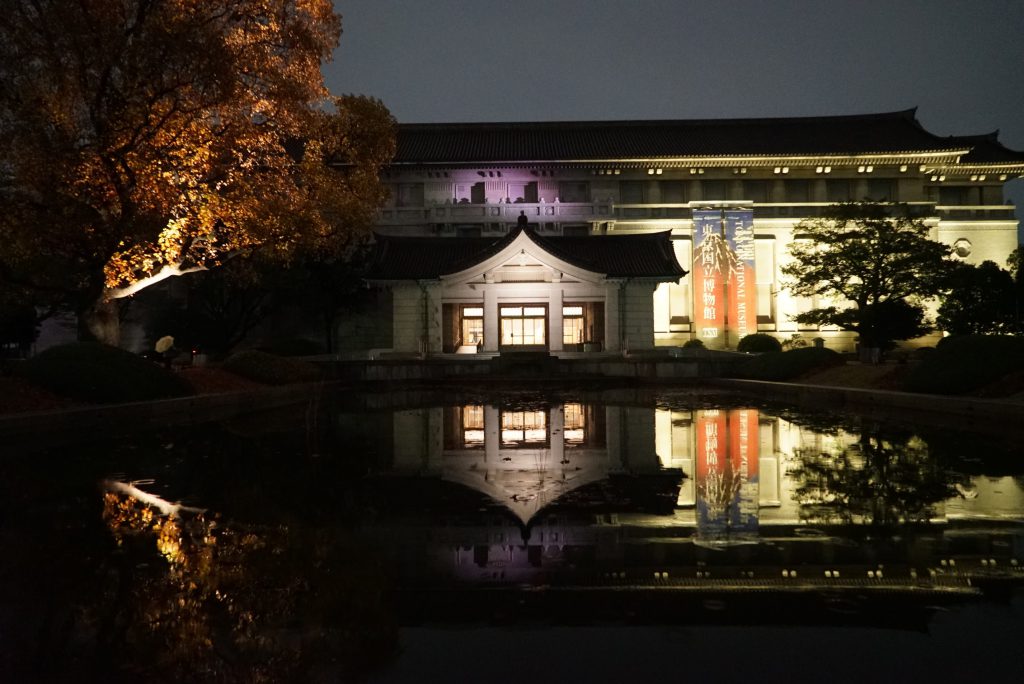
Presentation of concept of illumination and its review was carried out from each group.
■Group A:Main Building
The presentation of illumination started from black wall of main building that the light was shining through a little. Then, LED beam irradiates in 7 colors for 60 seconds each on a large wall. Some colors recalled us the time flowed on this ground, such as pink and green that represents change of the season, and red for flames of war happened in the last days of Tokugawa Shogunate. Changing the color of wall and eaves of a large roof from white that was uniformed into the color we chose: material color of the stone from the main building that also goes with the color of woods that has warmer tone was a teamwork of group members covering up light source of 9 lamps with filters to lower the color temperature from 5000 Kelvins to a half of it.
With everyone’s shout, Tulipifera in front of the main building lit up, and irradiated dancing dead leaves close up on the end of the big tree that’s like guardian deity, and revival of next spring. (Toru Mori)
■Group B: Hyokeikan
Group B was responsible for Hyokeikan, Neo Baroque style architecture made by Katayama Toukuma Design in Meiji. For profound atmosphere of main building, image of lady, dome roof in melon sorbet color, dark sunken front entrance, using banner for exhibition carried out right now, wall design of wings that gives flat impression, lions that decorates the scary entrance. We decided to do experimental illumination with these items not just for problem solving. Members focused on the dark sunken front entrance. Someone suggested to highlight the center by lighting inner entrance to outer, and to form banner in RGB color with depth including columns. We tested many things like applying contrast to planar imprinted outer wall of right wing by coloring convex part in white, and concave part in orange. Other ideas were to make building’s edge stand out more, uplit trees, and light with blue or purple from image of lady.
There was an idea to use reflector to apply shades to get floating feeling on stairs leading to front entrance.
Eventually, we decided the concept to float from ground to the sky, and lighting calling for daily life to extraordinary. We emphasized the front entrance with image of rising color temperatures from low to high. The statue of lions in the entrance was lit up from diagonally below to break away from scary image. We tried to invite to presence of columns and inner part of building by emphasizing entrance by illuminating with lower color temperature from the ground in front of stairs. We changed the direction of existing lighting fixture on dome roof a little. We didn’t illuminate the trees, but it made shadows that performed well on the wall. Because of the limited time and equipment, we only could have lit the right wing on the outer wall, but if we could try again, we want to challenge on lighting circles that goes around as a series of story of each seasons of main building-Hyokeikan-Horyuji Treasures. (Nobuyo Sato)
■Group C: Passage from front entrance to Horyuji Treasures
Group C was responsible for pathway from front entrance of Tokyo National Museum to Horyuji Treasures. Besides the pathway, there are many tall trees that stand out the darkness. The glare of security light and the darkness of trees makes a contrast which increases the spookiness, and it was difficult to walk up to Treasures located at the end of the pathway. The problem is that there aren’t many visitors to Treasures. So, our concept was “lightings that guide visitors to Horyuji Treasures”.
The opinions that were made in the discussion were, making changes to visibility by illuminating buildings and monuments in the pathway, unity that doesn’t offset other building’s illumination, and how to keep the balance of favor Horyuji Treasures as a final goal. In the workshop using lighting fixture, we walked while moving fixtures initiatively, and discussed and adjusted for each points like intersections.
We eventually chose three method; 1. Illuminate the leaves of trees that grow thick like tunnel, and have the floating feeling and keep the brightness of overall space, 2. Set up the bollard lighting and make point of sight intentionally to make relieved feeling to visitors, 3. To favor the Treasures, we balanced by moderating the illumination of Black Gate to blend in overall space. The achievement of the actual illumination was that we were able to reduce the glare and make a different scenery, and guiding illumination to Horyuji Treasures. Since there are many trees in Ueno Park, many sceneries that looks like ours exist. The suggestion we made this time is something that could be reflected to future lighting planning of Ueno Park. (Masara Akimoto)
■Thoughts through these 3 days
Everyone has their opinion like “I want make it more like this”, so it is not so hard to image and draw it out. On the other hand, there are times that can’t be realized with your own power, or it requires many lucks and opportunities. This time, Shomei Tanteidan was able to reproduce and verify the proposal through workshop actually using lighting fixture in front of the eyes.
I was very interested in ideas brought up from the workshop such as plans using LED of RGB and lighting in warm color, and proposal using shadows and reflections made by illuminating trees and water surfaces. Many people’s ideas and opinions were broken down and reconstructed by professional’s knowledge and experience, which I saw source of feasible new ideas.
I am very excited to imagine that this workshop’s idea is in the scenery of Ueno which is enjoyable both in the daytime and the nighttime. I am expecting to find one scene of new night in Ueno. (Haruka Takano)





